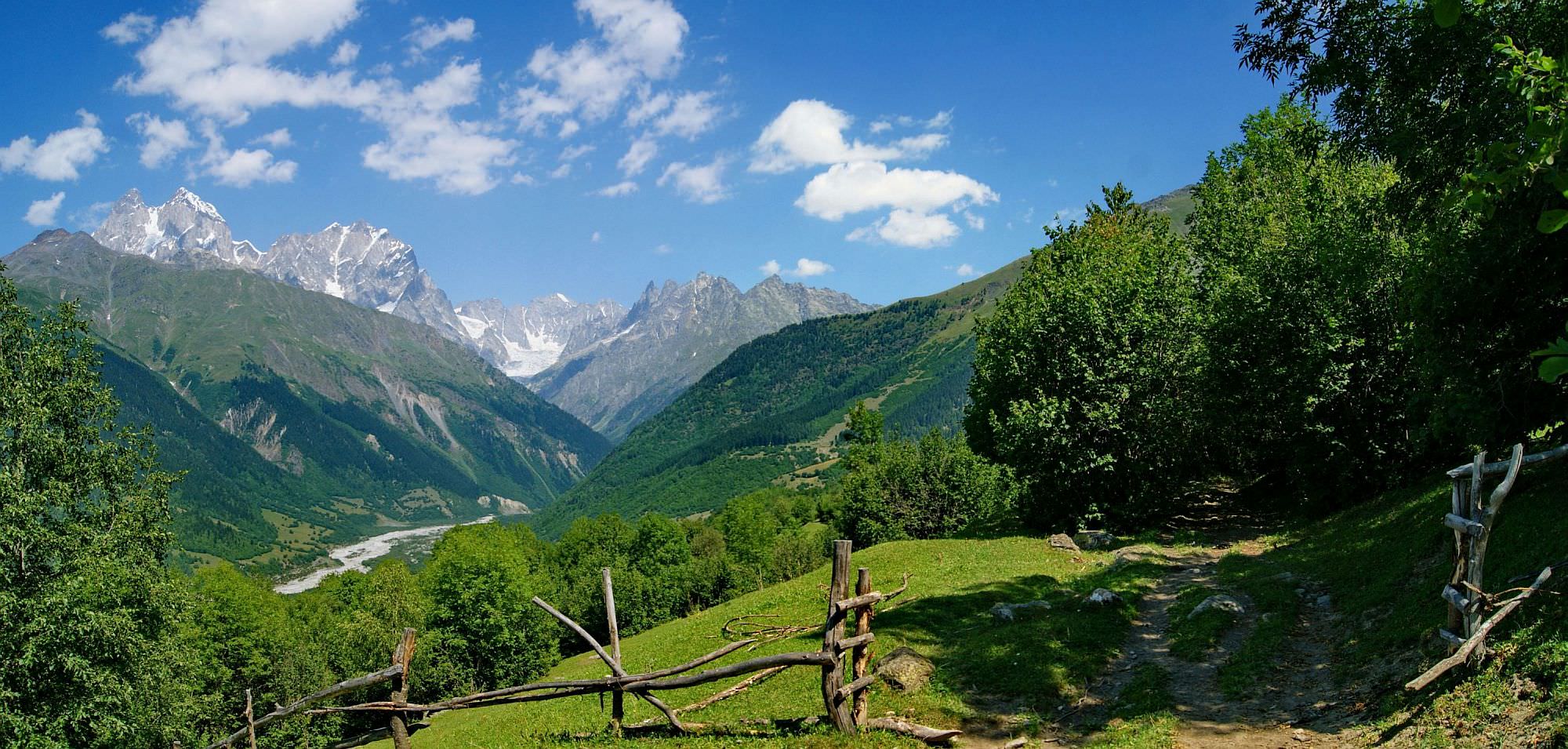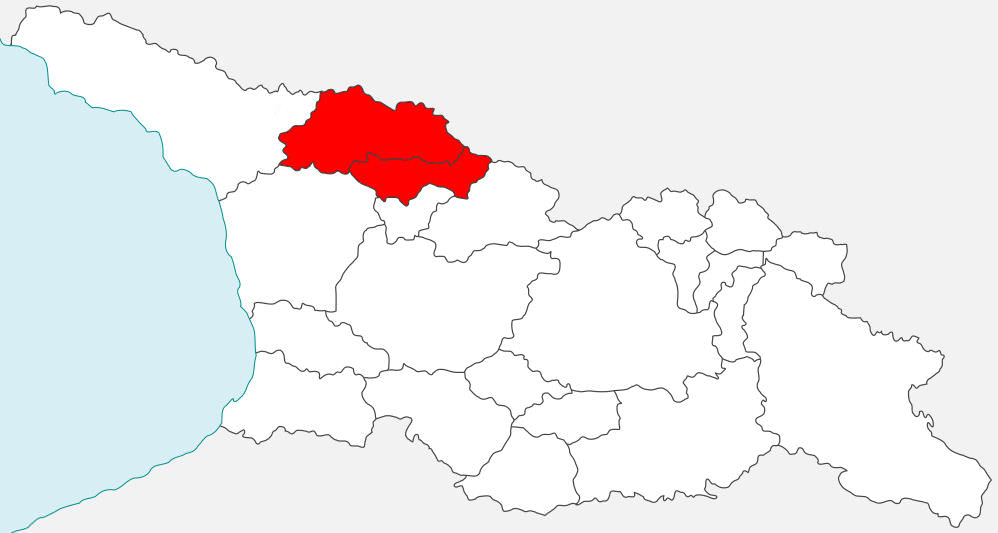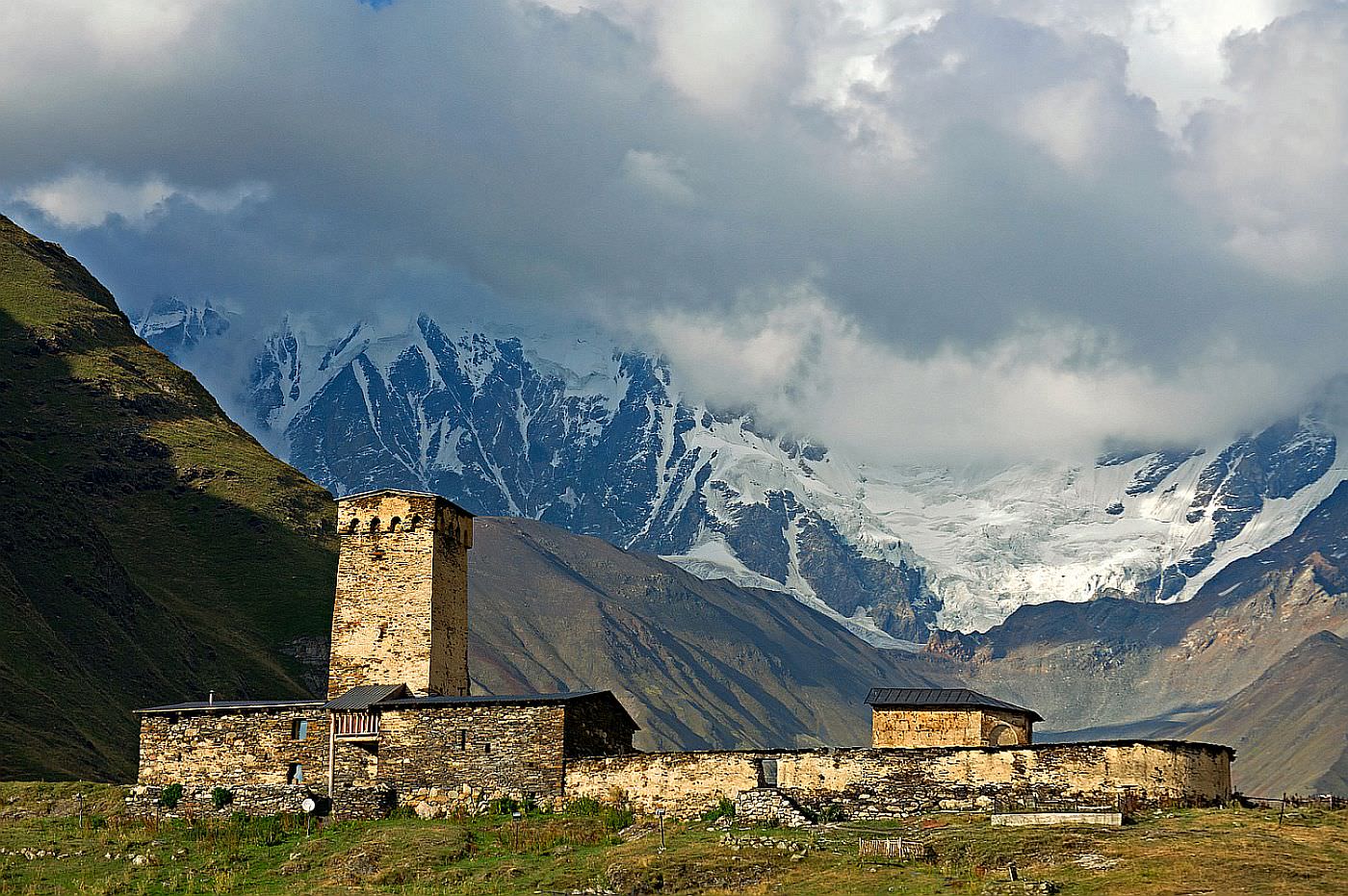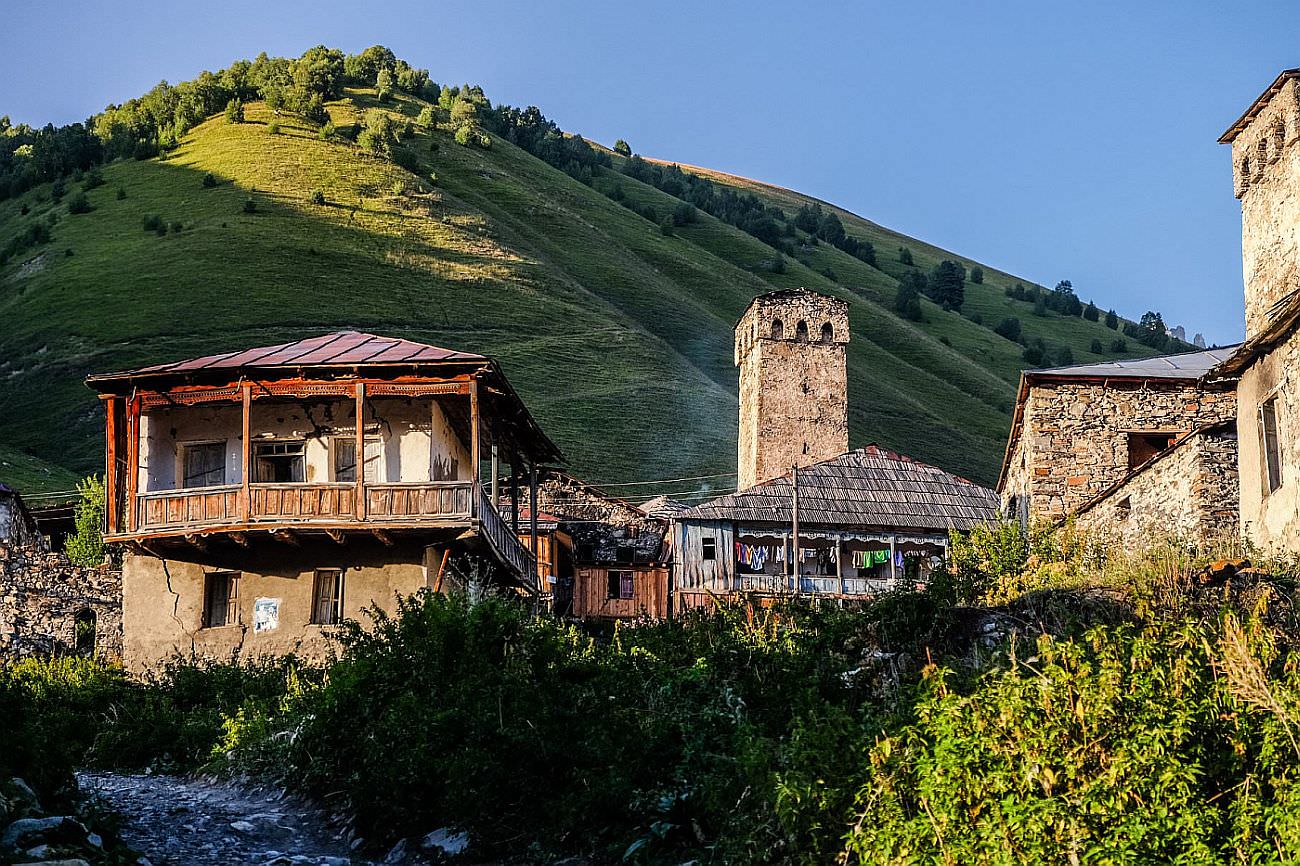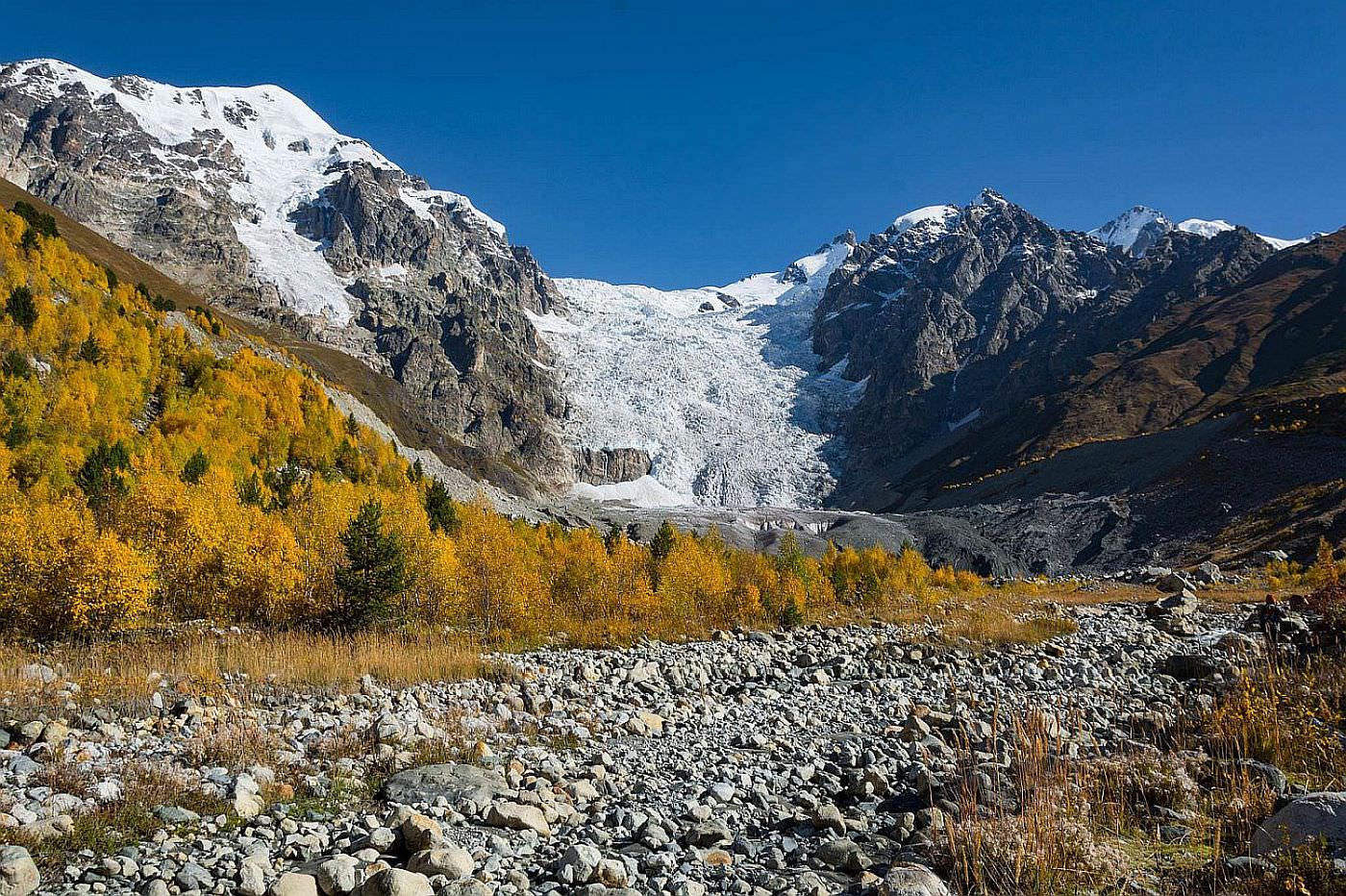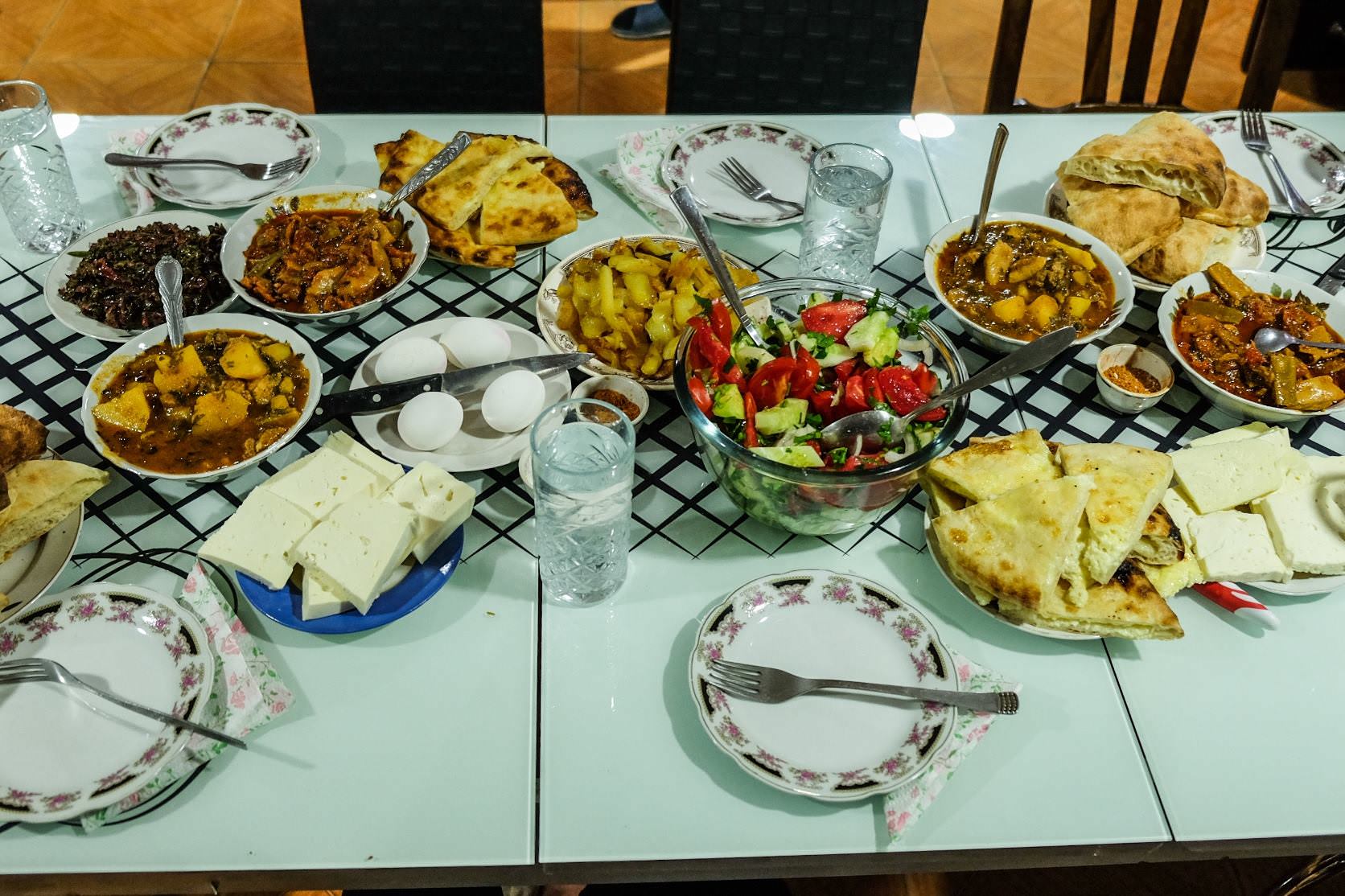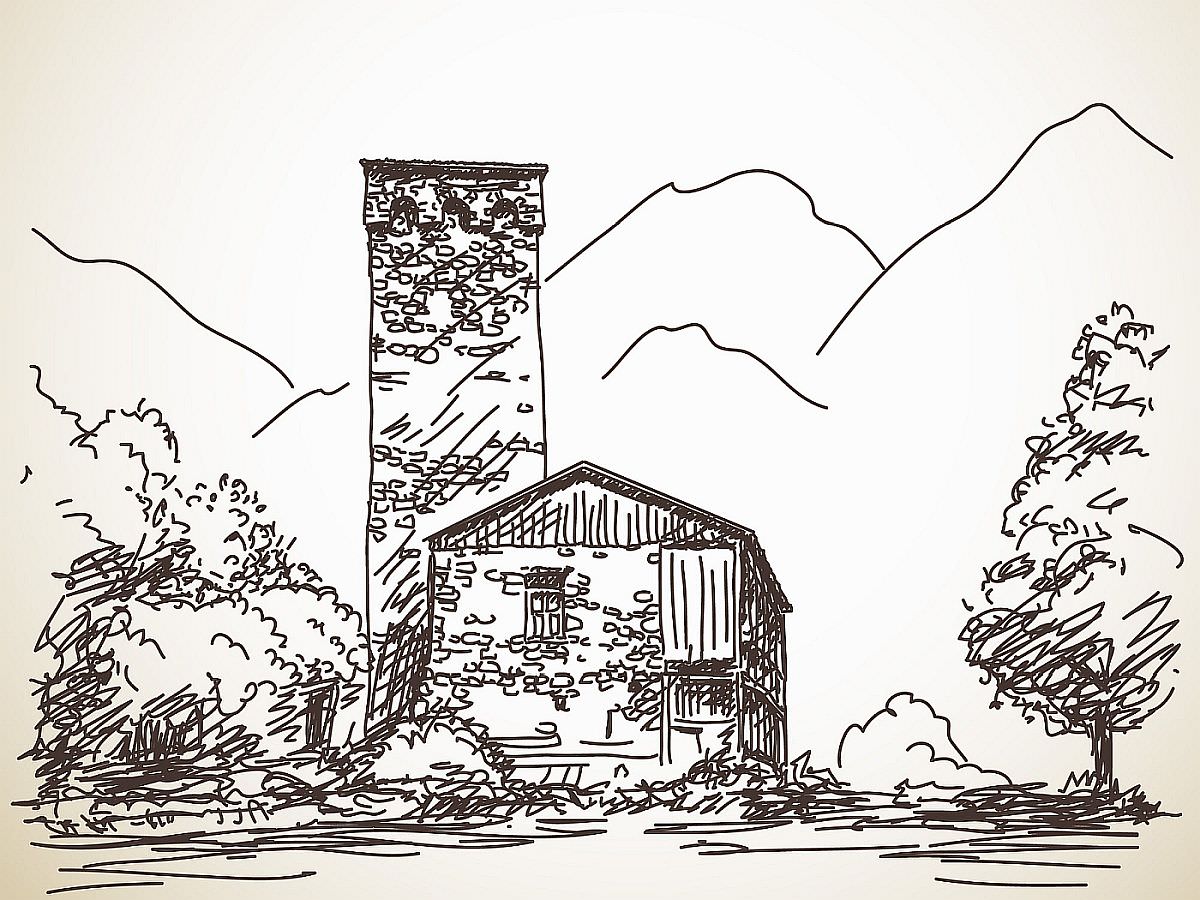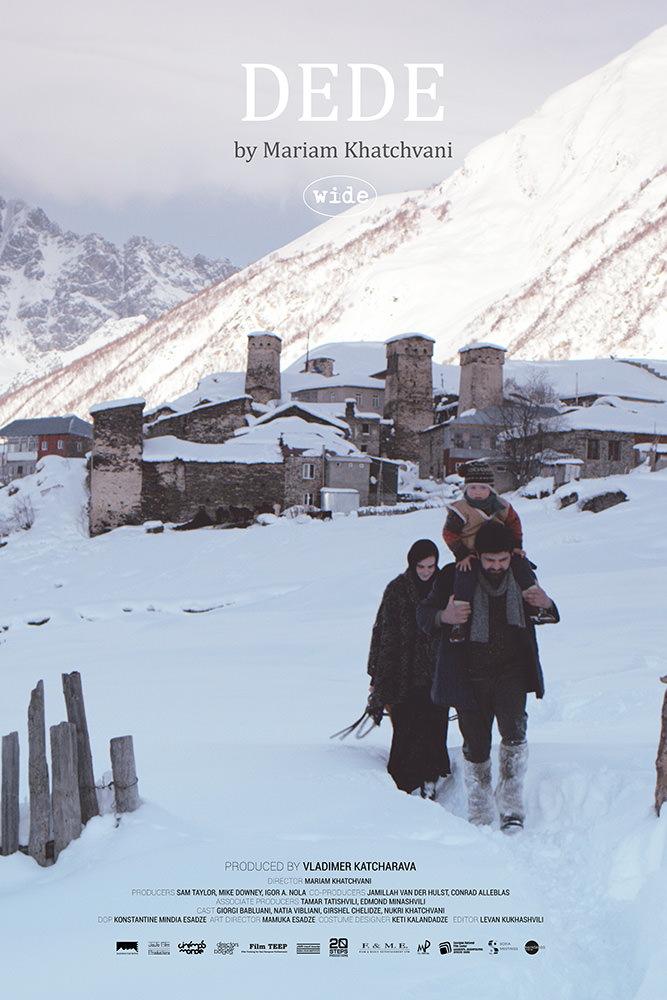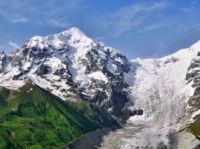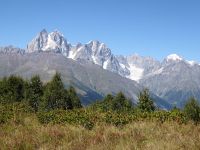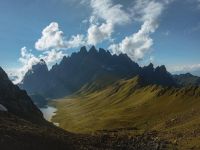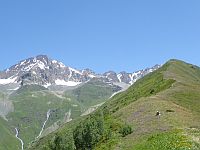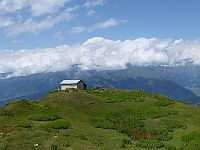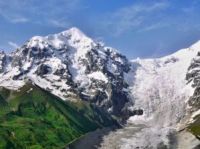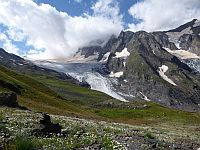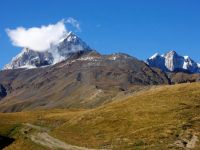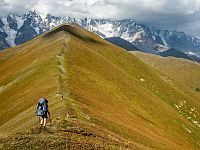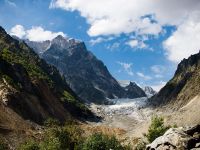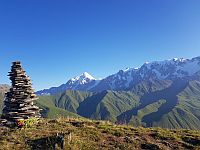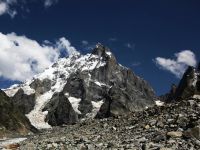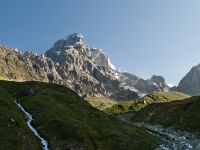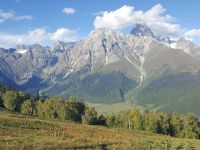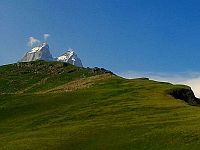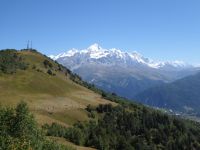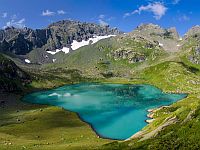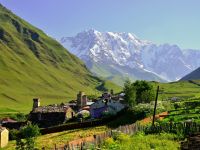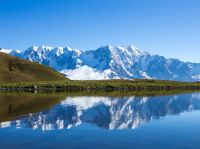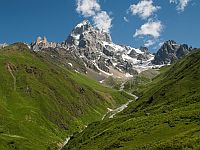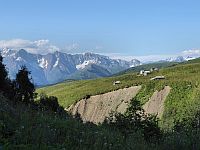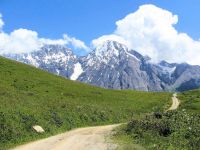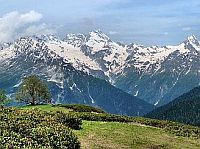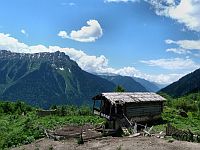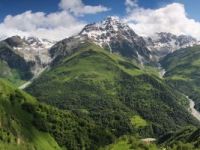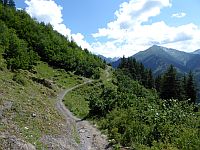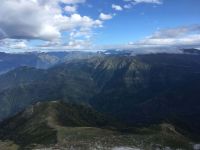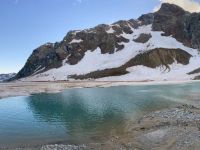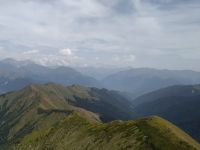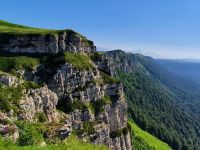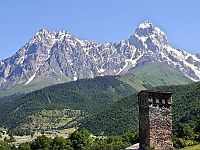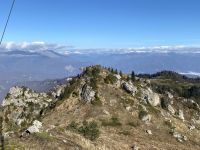Svaneti
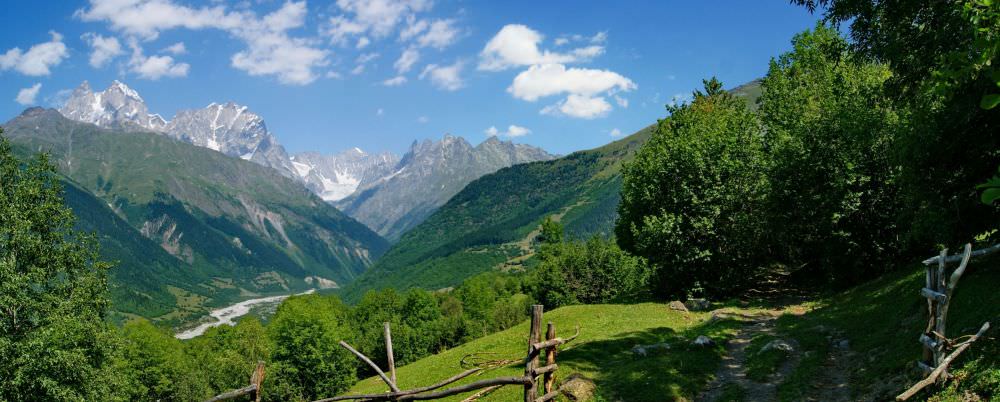
Soanes are foremost in courage and power. They are masters of the peoples around them, and hold possession of the heights of the Caucasus above Dioscurias. They have a king and a council of three hundred men; and they assemble an army of two hundred thousand, for the whole of the people are a fighting force. It is said that in their country gold is carried down by the mountain-torrents, and that the barbarians obtain it by means of perforated sheep skins, and that this is the origin of the myth of the Golden fleece.
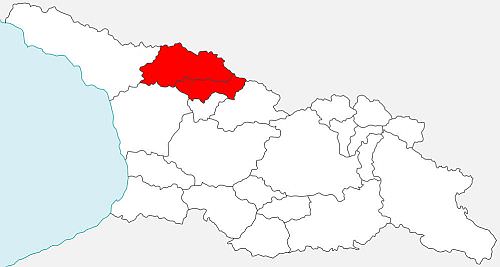
Svaneti is probably the most beautiful region of Georgia and the essence of what country can offer to the foreign tourists. All those stunning photos of historical stone villages, lush green valleys and snow-covered mountains.... the most of them were made here.
But mountains of Svaneti are also much more than catches the eye, not just glaciers, towers and instagrammable (oh, how I hate this word!) locations. First and foremost, for thousands of years they've been a homeland of Svans, a very distinctive ethnic group related to Georgians. Therefore, I don't want to limit this guide to the usual "how to get there and what to eat" fare. I would like to provide also an insight into history, traditions and challenges Svaneti has to face today to help you better understand this very interesting place.
PRACTICAL INFO
- 1. Getting around
- 2. When to visit
- 3. Where to stay
- 4. What to eat
- 5. Money, internet, etc
- 6. Things to do
- 7. Itineraries
UNDERSTAND SVANETI
- 8. History of Svaneti
- 9. Svan language
- 10. Svan festivals
- 11. Local issues
1. GETTING AROUND SVANETI
Svaneti region is situated in the northwestern Georgia along the southern slopes of Greater Caucasus mountains. It consists of two parts - Upper (Zemo) Svaneti and Lower (Kvemo) Svaneti. Upper Svaneti lies in the watershed of Enguri river. Surrounded by highest Georgian mountains, it is a popular tourist destination. Whenever you read in some foreign magazine about "Svaneti", the author actually means Upper Svaneti.
Lower (Kvemo) Svaneti lies in valley of Tskhenistskali river, separated from Upper Svaneti by the Svaneti mountain range. It feels like completely different world. It also has beautiful mountains, but simply pales in comparison to its northern neighbour. There are no towers and the villages overall don´t look so exotic or "medieval". Because of this, Lower Svaneti managed to retain lots of its original atmosphere. As a downside, tourist infrastructure leaves much to be desired.
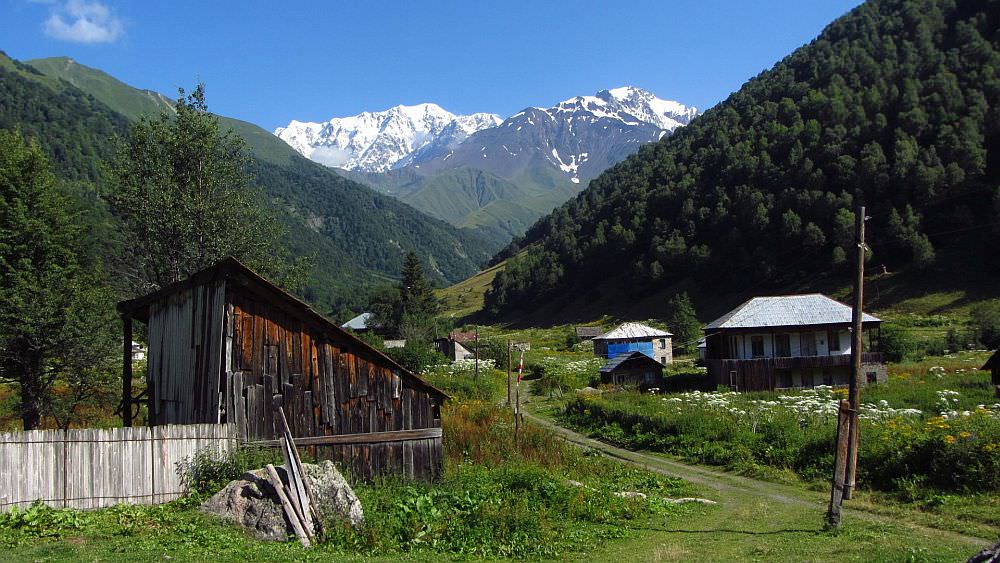
Tsana village in the Lower Svaneti
Getting in
The main road connecting Svaneti with the rest of Georgia runs along the Enguri river. Not so long ago, it used to be a dirt track full of potholes but the Georgian government had it rebuilt in an effort to boost the tourism in the region. The nowadays road is far from perfect, but is still used by absolute majority of travellers heading to Svaneti. Their destination is usually Mestia, the regional capital and a transport hub.
From Zugdidi to Mestia:
Marshrutkas to Mestia leave from Zugdidi every day, there is at least one in late morning and one in the afternoon. Morning marshrutka departs from the bus station situated by the bridge around 10 am (or even later if not full). Afternoon marshrutka waits for passengers of morning train from Tbilisi, which arrives around 14:30. Therefore, they wait in front of the Zugdidi train station. There might be some odd marshrutka in-between on you might get lucky and board marshrutka stopping at Zugdidi along its route to Mestia, but that cannot be guaranteed.
Either way, the price of the ride is 40 GEL and the trip takes almost 4 hours, mostly due to a rather large pause these buses tend to make around Khaishi.
If you get lucky or travel in a larger group, it could make more sense to secure your spot at shared taxi that depart from the station by the bridge (and in the afternoon from train station as well). The price tends to be 200 GEL per the whole car (50 GEL pp if the taxi is full), but varies depending on the situation. Trip is faster since any break is optional, takes 3 hours or so.
From Tbilisi to Mestia:
Few years ago, the best option used to be the overnight train to Zugdidi. However, it was cancelled in 2020 due to covid and there are no signs that it's going to be restored anytime soon. The only viable replacement used to be a long-distance night bus, which could also save you a lots of time, but won't be as comfortable as that cancelled sleeper train. Unfortunately, it seems that right now (summer 2023), they are not running them either, only bus leaving around noon, but it might be worth checking out Omnibus website to see if they were reinstated.
Currently, I would recommend the day train. It departs from Tbilisi at 8:20 and makes it to Zugdidi at 14:31, just in time to catch some of the last marshrutkas to Svaneti. The price of the ride starts at 16 GEL, which is less than 5 EUR. Tickets can be bought in advance at matarebeli.ge website (the official web is railway.ge, but that never worked for me). Just one important thing - tickets are released for the online sale only some 15 days in advance, but it's not explained anywhere. So don´t freak out if you can´t buy your ticket online because of the "no tickets available", "trains not found" or some similar error. Just try later :)
If you fail to secure the spot on the train, you may be forced to take a direct marshrutka - two minibuses depart at 7:00 from the area in front of Main Railway Station, come at least 30 minutes earlier to catch a spot. Another one departs at 8:00 from Samgori railway station and there should be something from Didube as well. The price is 40 GEL, so it´s quite cheap, but I can´t recommend it since this uncomfortable journey takes grueling 9-10 hours - basically, it's just slower, marginally cheaper and much less comfortable alternative for the day train.
If the are not travelling alone and don't mind spending some extra bucks, you might prefer a direct taxi. Those can be either arranged at bus stations or prebooked - looking at the prices of one of the most popular Georgian transport website, gotrip.ge, prices for the private transfer from Tbilisi to Mestia start at 650 GEL (230 EUR) for the group of 4.
The last option you could consider is flight - there are 4 flights a week from Natakhtari airport near Tbilisi, operated by VanillaSky company . You would see Caucasus from a completely different perspective and for 90 GEL it´s quite a bargain. On the downside, they occassionally get canceled because of the weather and during the summer, you should book at least month in advance since they get booked up pretty fast. For more info, pls check this excellent post about the flight (covers also flight from Kutaisi).
From Kutaisi to Mestia:
This depends on whether you want to get to Mestia from the city or from the Kutaisi airport.
In the first case, your best options is the direct minibus (the price is 40 GEL) departing from the station behind McDonalds. There is a fixed departure between 9:00 and 10:00 am, but if you want to secure your spot, better get there at 8:00-8:30 since it's popular among tourists and will depart much sooner if full.
According to locals, if this marshrutka gets full and leaves before 9:00 am, they will send another one. If it gets full later, they might not.
There may be also others during the day if there are enough tourists, but I wouldn´t rely on that. If you miss them and there is none other direct bus available, look for a marshrutka to Zugdidi (price 10 GEL) - it's the same way and you can find there transport to Mestia more easily (especially if you notify your driver in Kutaisi that you need to continue to Mestia).
If you are travelling directly from the airport, you also have some options. If you are travelling alone, you can arrange a transfer to Kutaisi at Georgian bus stand (5 GEL or so) and take marshrutka from there. Or, if you are willing to spend extra money and save time, find someone to share taxi with. It's actually pretty easy - do you see any people with hiking backpacks? If yes, there is a pretty high chance they are heading to Svaneti so this is a great chance to save some money and get to know some people.
If you are not alone and travel straight from the airport, you might want to book your taxi in advance. In this case, at gotrip.ge, prices of the transfer from the Kutaisi airport to Mestia start at 340 GEL, which is actually pretty solid. If you haggle with taxi drivers loitering around the airport and don't look to desperate, you might get a better price, but not by much.
From Batumi to Mestia:
Marshrutka is the only option, it departs from the main bus station. Since you will have switch the bus in Zugdidi (you may have to wait for several hours there), this ride takes a better part of the day. The first bus departs at 8:00 am, then there should be another one at 9:30 am.
The road along the Inguri river is not the only one connecting Svaneti with the outside world. Another road heads from Kutaisi to Lentekhi, capital of the Lower Svaneti. Here, it turns to the east and at the Mele village turns into an unpaved track - this is also the farthest point where you can get by the public transport. The road then continues to Ushguli in the Upper Svaneti (you actually have two available routes, through Zagar or Latpari pass), but is in a terrible condition so 4x4 car is recommended. In theory, one can hire a taxi for this route, but it rarely happens since the drivers are reluctant to drive it and ask a lots of money. Therefore, it´s mostly used by locals, tourists riding rented jeeps or bikers.
Getting around Svaneti
Getting around Svaneti can be both easy and complicated, depending on where you need to get. The road to Mestia (and further to Ushguli) sees a decent amount of traffic so have a good chance to catch some marshrutka, shared taxi or to hitch a ride.
Things get more complicated if you plan some smaller villages lying deeper in the side valleys such as Chuberi, Mazeri or Nakra. There is no public transport and little traffic in smaller side valleys so to get there, you may need a taxi. There are many taxi drivers in Mestia, but they are already quite spoiled so it´s recommended to ask several of them for a price. Below are the approximate (tourist) prices of taxi from Mestia to surrounding villages.
| Destination | Price in GEL |
|---|---|
| Mazeri (Ushba glacier hike) | 50 - 70 |
| Tviberi (Laila base camp trek) | 70 - 90 |
| Latali (Mkheri hike) | 20 - 30 |
| Ushguli | 180 - 200 |
| Nakra | 120 - 150 |
The another option is to ride by marshrutka (which travels only on the Enguri valley) as close to your destination as possible and then walk. Also, if you tell the driver where you need to get, he may be willing to make a detour for some extra cash.
The first marshrutkas to Zugdidi, Batumi and Tbilisi depart early in morning, around 7 am. every day in the morning at (these should be booked one day in advance). There are more during the day, depending on the demand. There should be also some marshrutkas departing in the afternoon to Zugdidi, just in time to catch the evening train to Tbilisi which departs at 17:25. However, since marshrutka schedules are not 100% fixed, better visit station in advance to confirm this and book tickets.
For exact timetables and booking of the tickets, visit the travel offices at the station. Just keep in mind that there are several offices and don't buy tickets too far in advance. We met tourists who entered the first office, bought there tickets for the next bus which departed in 2 hours and then had to wait even though there were several other marshrutkas (operated by another offices). If you can't find a suitable tickets and are not under a time pressure, I recommend just to grab a beer at the bar by the station, sit on the terrace and check the situation once in a while - sooner or later, some driver driver will show up.
If you prefer to have everything pre-planned, you might book a taxi in advance, especiallly if you are not travelling alone. The cost of prebookeded private transfer from Mestia to Tbilisi starts at 550 GEL. Of course, you might get an even better price if haggling with local drivers, it all depends on who you stumble upon. Svan drivers are often quite reckless - if you don't like the driving style of your driver, don't be shy and say so.
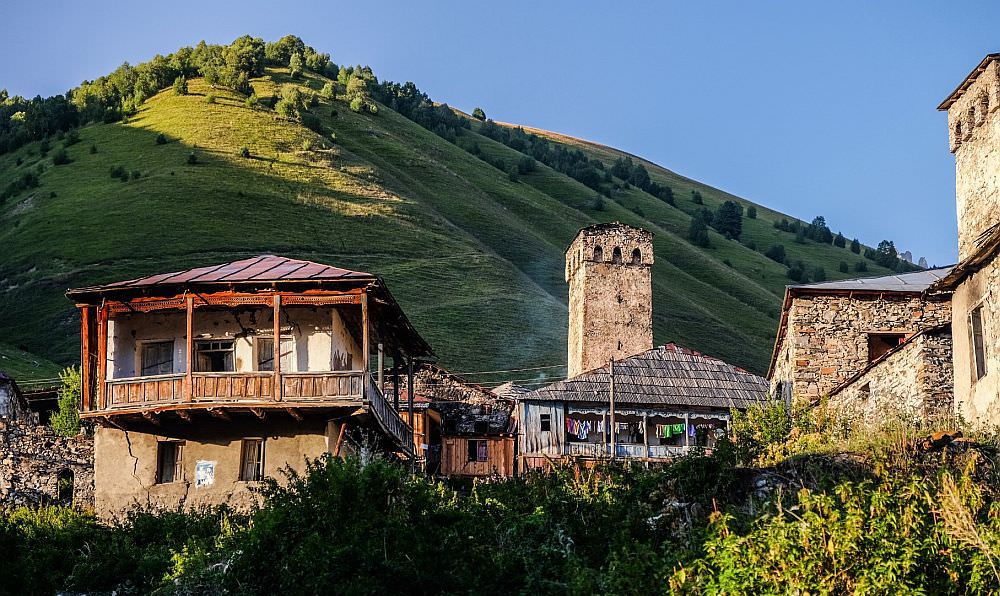
Svaneti, Georgia
2. WHEN TO VISIT SVANETI
Svaneti can be visited all year round but the majority of tourists come during summer (for hiking) and during winter (for skiing). Here is the brief overview of the individual periods:
Skiing season (December - mid April)
The skiing season in Svaneti starts in the second half of December and ends in the first half of April.In the vicinity of Mestia, there are two skiing resorts (Hatsvali and Tetnuldi) which offer trails or varying levels of difficulty. Apart from skiing and snowshoeing, there is not much to do, but Svaneti is still a great place to chill - the old villages look magnificent when covered with snow.
Spring season (April - May)
There is not much to do in Svaneti. It is already too late for skiing but too early for some serious trekking - there is still a thick blacket of wet, heavy snow at the mountain passes. If you plan to hike, you will be limited only to the easier strolls. Yet, this is actually a decent period if you plan to come only for the sightseeing since there will be only a fraction of tourists compared to the summer. However, keep in mind that landscape will be a bit "gray" after the winter.
Early summer (late May - June)
During this period, first more difficult hiking trails open (such as famous Mestia - Ushguli). Hikers can enjoy striking contrast between vividly green valleys and snowed mountains, blooming rhododendrons and many other flowers. However, it has a price - this period has more rainy days.
High season (July - August)
The busiest time in Svaneti (especially duringAugust). Mestia -Ushguli trail is crowded and it´s recommended to book your place at the guesthouses, yet I was surprised how few people I met at the other well-known trails such as crossings of Guli and Baki pass. The weather is mostly nice (even though also a rainy period can occur) and the days are hot.
Autumn season (September - mid October)
One of the best periods for trekking in Svaneti. The crowds have mostly left, but the days are still mostly pleasant and dry. At the end of September, trees get their characteristic autumn foliage and keep it till the first serious snows block the trekking trails in the second half of October.
Late autumn (late October - November)
Low season in Svaneti. Days are short, cold and there is overall not much to do. Autumn colors are gone and the place looks a bit depressing. Good period for people who like to visit famous places without the crowds.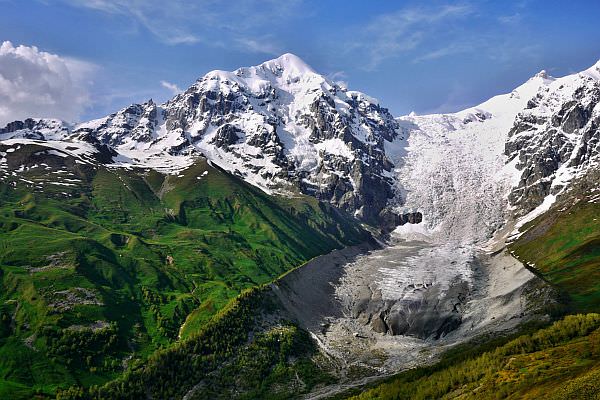
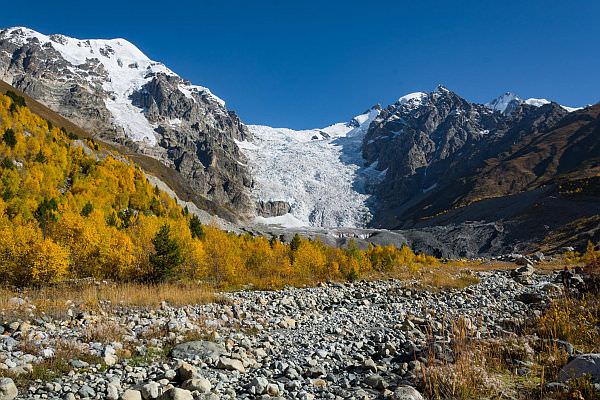
3. WHERE TO STAY
Most of the tourists stay in Mestia - this city alone has more hotels, guesthouses and homestays than the rest of Svaneti combined. I won't get into much detail here, I already wrote a longer post about accommodation in Mestia.
The offer in the smaller villages is more limited. With the exception of Mazeri and villages lying on the Mestia - Ushguli trail, you will find only one or two guesthouses per villages, if any at all. If there is none, just ask around. Georgians are masters of improvization and should be able to come with some solution.
There is also one more thing you should know, especially if you are using online booking portals. The price you pay (especially in villages) is often higher than the one advertised. That is because while you see only a price of the room while booking, landlords often assume that you will want also full board, prepare it and charge you (even if you don´t ask for it). To avoid misunderstanding, I recommend to ask in advance about prices of these meals and if you don't want full board, announce it beforehand.
Looking for a place to stay in Mestia before the trek?
These are my favorite guesthouses
4. WHERE TO EAT
In Svaneti, there are basically two kinds of places where you can get a warm meal - restaurants and guesthouses. Restaurants can be found in Mestia, Ushguli and along the Zugdidi - Mestia road. They work like everywhere else - you order the food, get what you asked for and pay for it. But, to be honest, I am not a big fan. In Svaneti, I´ve tried many restaurants but all of them ranged between "below average" (mostly because of service ) and "just ok". I have some places which I visit without qualms when around, but I have yet to find a place which would stand above the rest and where I would return year after year. I still visit restaurants to get a few beers, fries and so on, but when I need a proper dinner, I order it at my guesthouse.
If you are staying at the guesthouse, you usually can order breakfast and dinner (and on Mestia - Ushguli trail also a lunchbox). Breakfast usually costs 10 GEL, the dinner 20 GEL. That´s much more than a price of a single dish in a restaurant but when you consider that you get also a soup, can pick from several meals and salads and don´t have to pay for a drink, it´s suddenly not expensive at all. Also, I think the food at homestays with good cuisine has higher quality and is more varied when compared to any restaurant in Svaneti.
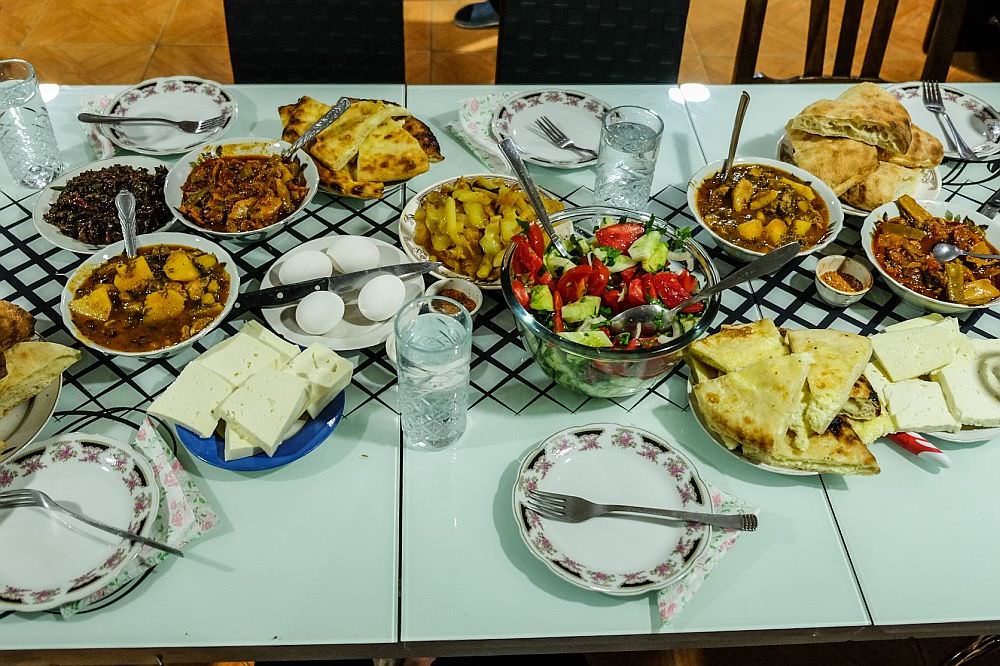
Dinner for two at one of those better guesthouses
Also, since this section is about food, let´s briefly mention some typical Svan dishes. Because of the natural conditions, Svan cuisine is not as varied and refined as a cuisine of Georgians living in the lowlands. It is simple, hearty and filling. The signature Svan dish is kubdari - flatbread filled by ground meat, onions and herbs (basically, it is a khachapuri with meat). Another popular meal is chvishtari, small crispy loaves of cornbread filled with cheese. And last but not least is tashmijabi, which is essentially a potato puree with cheese. Staple ingredient of Svan cuisine is also Svan salt (svanuri marili), a popular seasoning mix (and also a great souvenir). It is a mixture of sea salt, dried garlic, fenugreek, coriander, chili pepper, dill and several other herbs. It goes nicely with roasted potatoes or chicken meat.
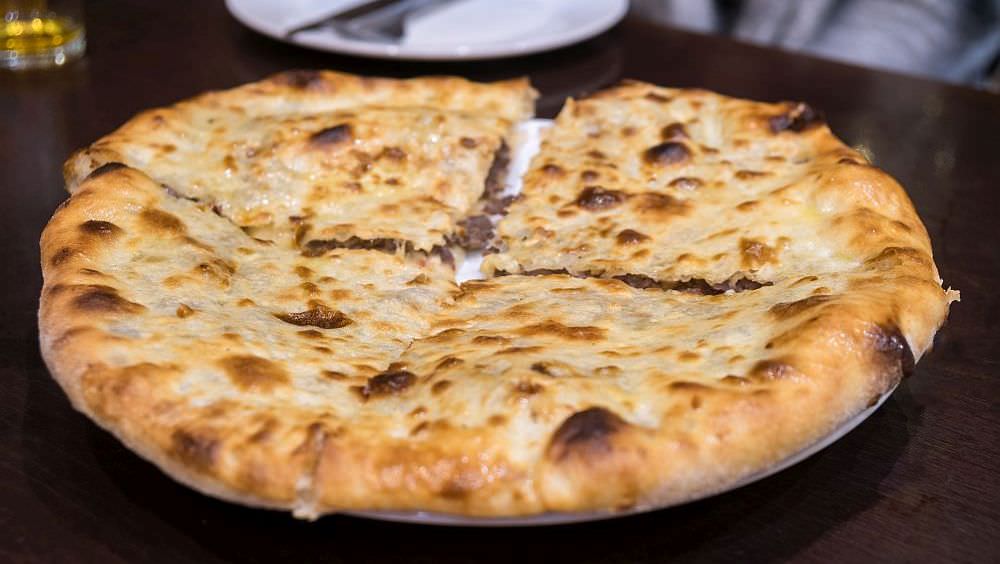
Svan kubdari
5. MONEY, INTERNET, MEDICINE
Money
While in Svaneti, it´s better not to rely on your bank card and just pay everything with cash. While some restaurants accept cards, the majority of guesthouses and other shops don't.If you didn´t bring enough GEL (Georgian currency) to Svaneti, you can still get it in Mestia. There are two ATMs and several currency exchanges. But when going to smaller villages, always bring enough cash - if there is no other option, locals may be willing to accept Euros or Dollars, but at a pretty bad rate.
Internet connection
Svaneti has surprisingly good coverage. The signal is strong not only in tourist hotspots but also on the mountain ridges and other elevated places. For example, we had 3G at places such as Koruldi ridge, Gorvashi pass or Latpari pass.Of course, to use this coverage, you will need also wi-fi or your own sim card with prepaid data. I strongly recommend the latter - while many guesthouses offer wi-fi for free, you get what you pay for. These networks are often hopelessly overloaded by other tourists and trying to access anything through them is the exercise in futility.
Much better is to have your own sim card (can be bought right at the airports). Georgia has three major phone operators - Magti, Geocell and Beeline. They all offer some kind of a tourist package which usually contains some calls as well as 3GB of mobile data. I prefer Magti since it has the best coverage, especially in the mountains. If you decide to buy the sim car in Mestia, you will have to stick with Beeline since it is the only operator which has a booth there (right at the Seti Square).
3GB of data is a lot, but can be spent - especially with the assistance of stingy friends who didn´t buy their own simcard and then keep nagging you about a wi-fi hotspot 🙂. Luckily, there is an option to buy more. In several Mestia stores, you can see orange or blue payboxes which you can use to send some credit to your phone number. Once you have it, call " 11** " to access menu where you can spend it (but it is only in Georgian so ask some friends or your landlord to do it for you).
Hospital & pharmacies
Mestia has a small but pretty modern hospital situated in the western part of the city. So far, I didn't have a reason to visit ("knocking on wood") but spoke with few people who did (spained ankle, dog bite) and they were satisfied with the level of the treatment they got.In the city, there are also two pharmacies. Pharmadepot is larger one and can be found in the hospital building. The other one, Seti Pharma, is is situated in the city center, right by the Police station. The staff here doesn´t speak English so you will witness here a lots of foreign tourists practicing their pantomime.
6. WHAT TO DO IN SVANETI
Trekking and hiking
I assume you this is not new to you since you are on this web, but Svaneti is a great trekking destination. It offers a wide range of trails of varying length and difficulty. One of the greatest advantages of trekking in Svaneti is that villages are located densely enough to allow for a "guesthouse trekking" - you can spend up to 8-10 days on the trail without having to sleep in a tent. And of course, there are also many more remote treks where you will utilize a tent.An extensive list of treks is available on a separate tab. If you are interested mainly in hikes, check the list of walks you can do around Mestia, the best base for day hikes in Svaneti. Another post covers best hikes in the vicinity of Ushguli, maybe the most photogenic Svan village.
Mountaineering
In spite or many hiking trails Svaneti offers, only a very few of them climb some mountain (mainly because they follow old shepherd paths). Therefore, if you wanna get high, you will have to spend some extra effort. The most popular climbing peaks in Svaneti are Mt. Laila (4008m), Tetnuldi (4858m), Banguriani (3838m) and Ahalgazrdoba (3702m). But to brave any of them, you will need either a sufficient experience or a guide. Then there is Mt. Shkhara (5193m), the highest mountain of Georgia and Mt. Ushba (4710m), which is considered to be the deadliest mountain in the Caucasus.
Skiing and
Svaneti is also an emerging skiing destination. On a relatively small area, you can find two brand new skiing resorts. Hatsvali lies at the edge of Mestia and offers runs for beginners and intermediates. The upper cable car station lies on the top of Zuruldi ridge at the elevation of 2350m.Tetnuldi is the newest Georgian ski resort, opened only in 2016. It lies beneath the mountain of the same name, some 15 km away from Mestia. It caters to more skilled skiers and lovers of freeriding. The highest station lies at the elevation of 3165m. Overall, Tetnuldi still feels a bit rough and "unfinished" but has a great perspective and in a few years may grab from Gudauri the title "the largest Georgian ski resort".
Are you into ski-touring? You may want to check out our
Svaneti skitouring tour
Mountain biking
Svaneti also offers many opportunities for mountain biking. While the Zugdidi - Mestia road is very busy and not the safest place for a biker (mildly speaking), there are many dirt roads in the region with nice profile and almost non-existent traffic. Also some hiking trails can be tackled on a bike, though definitely not all of them, as these bikers learned the hard way :). The most popular is the route which starts in Mestia, heads east to Ushguli, then crosses Zagar pass to Lower Svaneti and turns west to Lentekhi.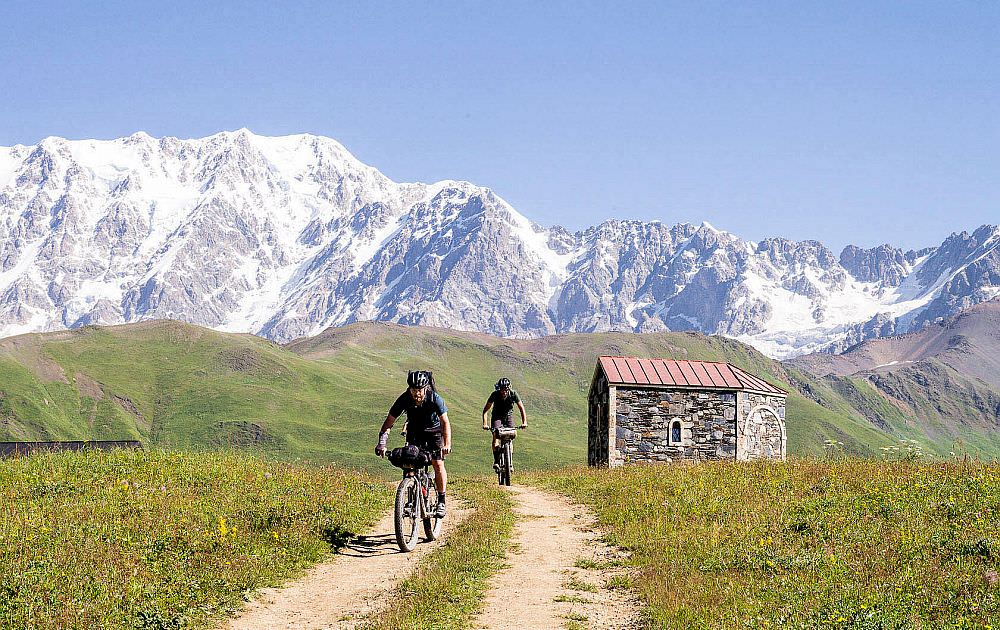
Horse riding
In Svaneti, you have also an option to do some horseriding. This activity is not as popular as one would expect and currently, the most profitable horse is the one which shuttles tourists over Adischala river on the Mestia - Ushguli trek. Yet, there are several villages which are good bases for horse trips. Mazeri village is a great for trips to the Shdughra waterfall or towards the Baki pass and Ushguli is a good base for horse trips to the Shkhara glacier or the Zagar pass.
Rafting
Looking at its wild rivers and spectacular setting, it´s not hard to understand why Svaneti is also a premium rafting destination. However, the infrastructure and information are still lacking so this activity is still in its infancy. Currently, the rivers of Svaneti are mostly braved by Georgian and Eastern European rafting clubs. The most popular rivers are Nenskra and Enguri in the Upper Svaneti and Tskhenistskali in the Lower Svaneti. Their difficulty levels start at III-IV, which means they are suited for more experienced rafters. If you ever stood on the Mestia bridge and looked down into the Mulkhura gorge, you will surely understand why :)
Admiring old churches
In Svaneti, one can find also many churches, many of them being 1000 old. These buildings are often unassuming and many tourists pass them, not knowing about the antique frescoes they treasure. Yet, it shouldn´t be that hard to get inside - even if the church is locked, if you ask around, you should be able to find someone to unlock it and show you around (for a small fee).The village most famous for its sacral architecture is Latali, which used to be one of the richest villages in Svaneti. Once, it boasted 60 of them, so it had more churches than living houses. Nowadays, only 25 of them remain, mostly serving as family shrines. The main Latali church is Matskhvari (Saviour's church), treasuring preverved 12th century paintings by Miqael Maghlakelidze. Nearby also stands the only church in Georgia devoted to Prophet Jonas.
Another interesting group of churches is situated along the short stretch of Enguri river, in villages Kala, Iprari and Nakipari. Here, you can see some of the nicest frescoes in Svaneti - they were painted by King David´s court painter Theodore over a timespan of 40 years. Just be prepared they are not in the best condition since they weren´t touched in hundreds of years (Georgian government only recently launched the initiative for their restoration).
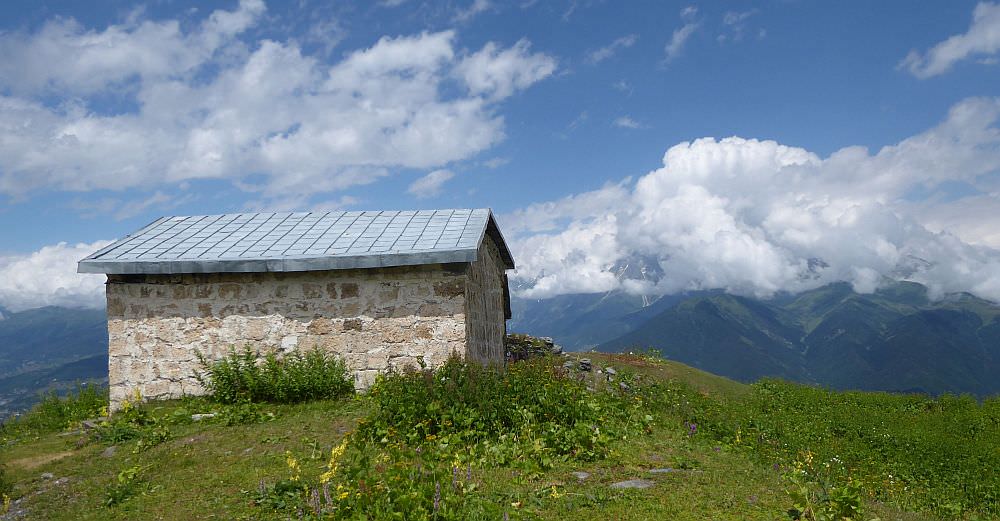
Mkheri church above Latali
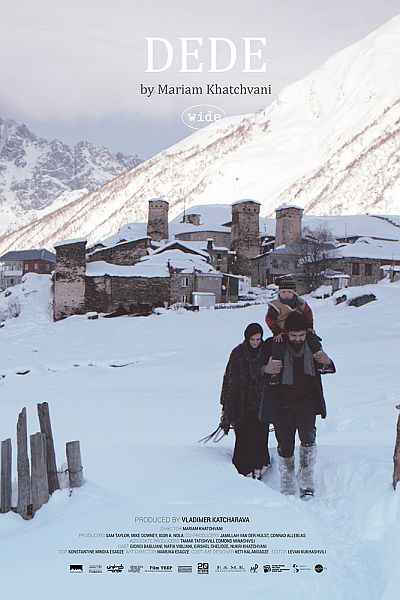
Going to movies
Or, exactly, going to the movie. In Mestia, there is exactly one cinema, "Dede Pub & Cinema". And it plays exactly one movie - however, a very special one. Dede takes place in the mountains of Svaneti during the early 90s and tells the story of a woman who tries to find happiness in life and has to her struggle with local traditions. The movie was shot by Mariam Khatchvani who was born and raised in Ushguli and almost all roles are played by local people with no previous experience with acting. In spite of this, Dede won awards at several prestigious movie festivals.And what do I think about it? I really liked it. There were some issues with the pacing but the overall atmosphere is really good, thanks to the stunning shots of the nature and depiction of various local customs and traditions. And when the movie ended and I left the screening room onto sunny streets of Mestia, I realized that the movie really "did it" - for 90 minutes, it took me back in time and space, to harsh, snowy Ushguli.
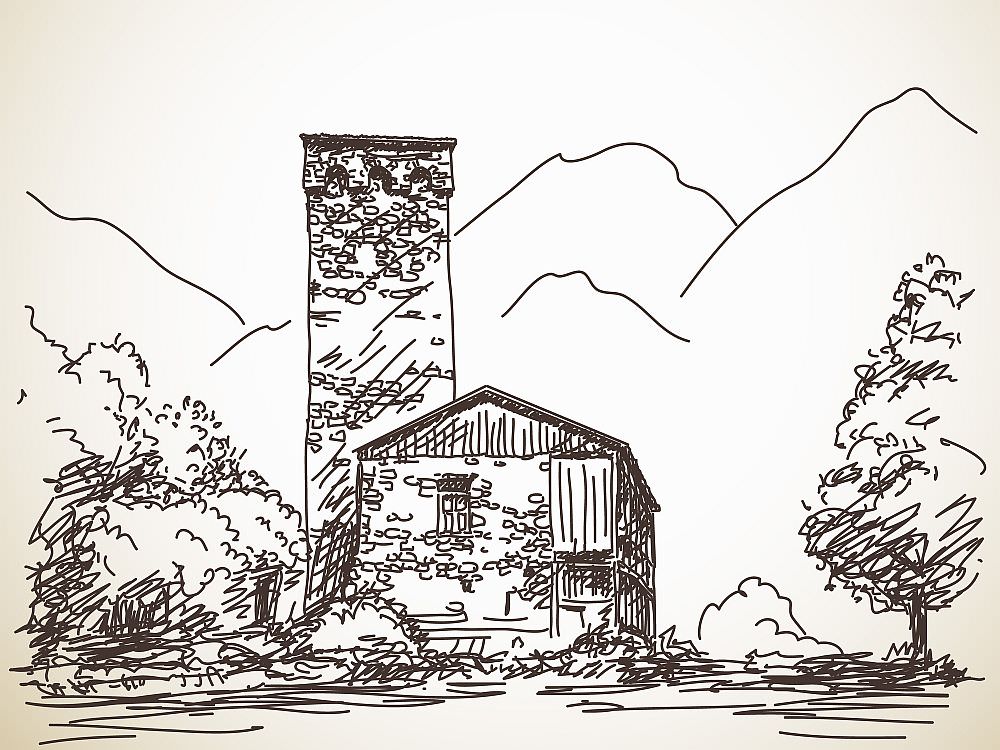
Sightseeing
And last but not least, there is also good old sightseeing. There is a certain charm in visiting various old villages, roaming their muddy streets and admiring the traditional Svan architecture. The most impressive are the villages west of Latali which were part of "Free Svaneti" and therefore developed typical tower houses (which had no purpose in villages belonging to Georgian nobility). My favorite of them is Lakhiri which retained a lot of its original atmosphere and looks simply stunning against the backdrop of the Tetnuldi mountain. A few more interesting places can be found here.7. ITINERARIES
A few ideas how to spend your time in Svaneti. Some itineraries are made for "tourists" - people who don´t come to Svaneti primarily to hike but are willing to stretch their legs a bit if it gets them to some nice places. These provide enough extra time for breaks, beer and eating. Other itineraries are for "hikers" who are fit and willing to hike a lot (but didn´t bring their camping gear).
TOURIST
3 days
Day 1: Transport from Zugdidi to Mestia, in the afternoon hike to the cross on the Tshakazagari mountain (or you can just take a car there, prices for a ride start at 100 GEL).Day 2: Drive by Hatsvali cable car to the top of Zuruldi ridge. Stroll on the ridge to the transmitter and back. Return to Mestia, visit Svaneti museum or Margiani tower museum. In the evening, see the Dede movie in the local cinema.
Day 3: Daytrip to Ushguli by shared taxi.
5 days
Day 1: Transport from Zugdidi to Mazeri. Walk to the Shdughra waterfalls.Day 2: In the morning, take a taxi to Mestia. Hike to the cross (or just take a taxi there or even to Koruldi lakes and back) and visit Svaneti Ethnographical museum.
Day 3: Drive by Hatsvali cable car to the top of Zuruldi ridge. Stroll on the ridge to the transmitter and back. Return to Mestia, visit Margiani tower museum. In the evening, see the Dede movie in the local cinema.
Day 4: Trip to Ushguli. Find a guesthouse, then explore the village and climb to the Queen Tamar tower. Sleepover in Ushguli.
Day 5: Walk, ride the horse or drive to the Shkhara glacier and back. Transport to Mestia.
HIKER
3 days
Day 1: Transport from Zugdidi to Mestia. In the afternoon, ride by the Hatsvali cable car and stroll on the Zuruldi ridge. Visit of Svaneti museum or Margiani tower museum (or both).Day 2: Hike to the Chkhuti ridge.
Day 3: Daytrip to Ushguli by shared taxi.
5 days (dayhikes, using Mestia as a base)
Day 1: Transport from Zugdidi to Mestia. In the afternoon, ride by the Hatsvali cable car and stroll on the Zuruldi ridge. Visit of Svaneti museum or Margiani tower museum (or both).Day 2: Hike to the Chkhuti ridge.
Day 3: Hike to the Mkheri church.
Day 4: Daytrip to Ushguli by a shared jeep.
Day 5: Hike from Mestia to Mazeri over Guli pass. Then take taxi back to Mestia (best pre-arranged). Of course, these days can be rearranged as you see fit. The good weather is the most crucial for days 2 and 5.
5 days (village-to-village hiking)
Day 1: Transport from Zugdidi to Mestia. In the afternoon, ride by the Hatsvali cable car and stroll on the Zuruldi ridge. Visit of Svaneti museum or Margiani tower museum (or both).Day 2: Hike to the Chkhuti ridge. Descend south towards Lakhiri and spend a night there. If this looks too demanding, just do the day 1 of classic Mestia - Ushguli trek
Day 3: Hike from Lakhiri to Adishi (a bit longer than classic Zhabeshi - Adishi route, but completely doable).
Day 4: Hike from Adishi to Iprali.
Day 5: Hike to Ushguli, explore the village and return to Mestia in the afternoon by shared taxi.
8 days (village-to-village hiking)
Day 1: Transport from Zugdidi to Etseri. Swift hike to Mazeri.Day 2: Hike from Mazeri to Mestia.
Day 3: Recovery day - visit museums, treat blisters, eat and sleep.
Day 4: Start of the trek from Mestia to Ushguli via Tsvirmi.
Day 5: Trek from Tsvirmi to Adishi.
Day 6: Trek from Adishi to Khalde.
Day 7: Trek from Khalde to Ushguli over the Lagem pass. The night in Ushguli.
Day 8: Hike from Ushguli to Chvelpi (or even to Maami if you are fast enough). As an alternative, you can descend from Latpari pass north to Kala village in the Upper Svaneti.
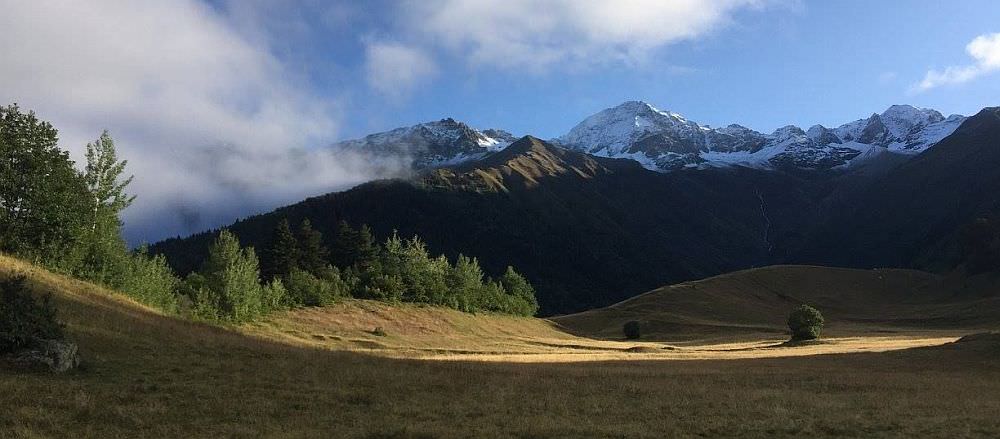
8. HISTORY OF SVANETI
Svans inhabited the Caucasus mountains since the antiquity but first were mentioned only by Greek Geographer Strabo in 7. B.C. Their lands originally belonged to the Kingdom of Colchis, known from the Greek mythology as "The Land of the Golden Fleece". After dissolution of Colchis, it became a part of a Roman province Lazica but kept a great degree of independence. In the 6th century AD, the whole province was a subject of bitter wars between Byzance and Sasanid empire. In the 9th century, Svaneti joined the Kingdom of Abkhazia and together with it was in the 11th century incorporated into the Kingdom of Georgia.
The Golden Age of the Georgian Kingdom in the 12th century brought prosperity also to Svaneti - from this period originate the most beautiful churches and works of art. Svans still have great respect for Georgian queen Tamar, who fell in love with the province and regularly visited it.
Once the kingdom collapsed in the 15th century, Svans of Upper Svaneti formed so-called Free Svaneti, a loose confederation of self-governing communities. There were ruled by local councils comprised of adult men and women. Still, feuds were quite common - that’s why each clan built towers Svaneti is nowadays famous for. Blood feuds were usually regulated by mediators according to the traditions, but towers were still necessary when things got out of control.
Those times of freedom/anarchy ended in the 19th century when the region got conquered by Russia. There were several unsuccessful revolts - the most famous of them occurred in 1876 and was ended by the destruction of Khalde village.
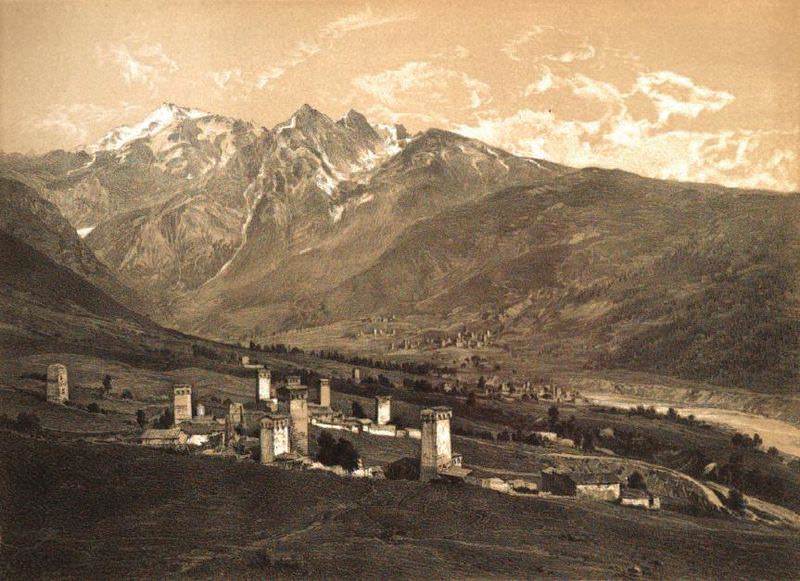
Svaneti in 1875
The most important event under the Soviet rule was a series of avalanches in the winter of 1986-1987 which killed more than 80 people. As a result, almost ten thousands of Svans were evacuated, mostly to the semi-deserts near the Azerbaijani border.
After the dissolution of the Soviet Union, Georgia fell into chaos and Svans temporarily gained de-facto an autonomy. Svaneti got quite dangerous at this period - since there was virtually no police, some Svans turned to banditry and kidnappings. Only in 2004, the Georgian government sent an army to the area, busting the worst troublemakers. And the rest quickly learned that there are other, more peaceful and sustainable strategies to get the tourist money.
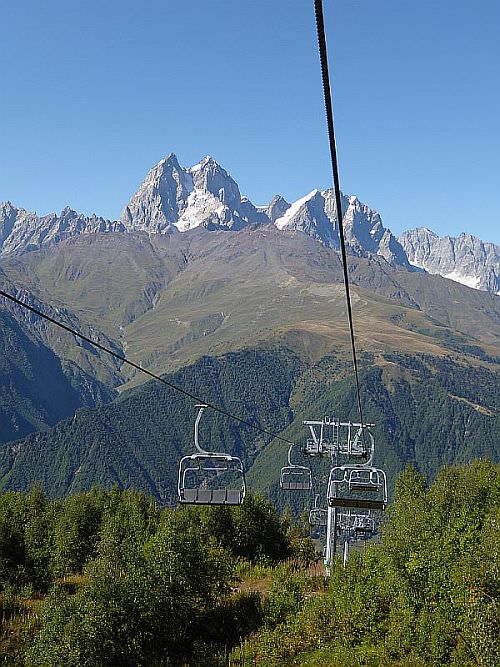
Hatsvali, the first skiing resort in Svaneti
Unfortunately, the result is in some cases debatable, with the capital od Svaneti, Mestia, being the prime example. The center of the city was rebuilt into something resembling Swiss village. Same with the new church of St. Nicholas which sticks out like a sore thumb since it wasn´t built in a traditional Svan style but in the one typical for the lowlands. And if you want to make a Svan mad, start singing the praise of the new Queen Tamar statue at the central square. While made by a famous sculptor, it´s simply too artsy for the liking of the locals so the government rather decided to install it overnight.
In 2004 started another era in the history of Svaneti. The government of Mikhail Saakashvili pledged to turn it into “Switzerland in the Caucasus”, world´s premium tourist destination and spent millions of dollars on the infrastructure and promotion. A new airport was opened in 2010. The road connecting Mestia, with lowlands was rebuilt and currently, it´s being prolonged all the way to Ushguli. Two brand new ski resorts, Hatsvali and Tetnuldi sprung up in the vicinity of Mestia. And there are talks of the tunnel connecting Mestia with Lentekhi to the south.
Still, for nature lovers, there are still enough places to see "unchanged" Svaneti. Most tourists are concentrated in Mestia, many make day trips by jeeps to Ushguli but most of them are not interested in serious trekking. The trail from Mestia to Ushguli is the most popular Georgian trek, but still only a little frequented by Western standards.
9. SVAN LANGUAGE
Svan (lushnu nin) belongs to the family of three Kartvelian languages (the other being Georgian and Mingrelian). It was the first language to split from proto-Kartvelian language family some 5000 years ago and nowadays is incomprehensible to the Georgian speakers. Yes, it is often incorrectly considered to be a dialect of Georgian.
Nowadays, it has about 20 000 speakers and belongs to the endangered languages (as all other local languages in the Caucasus). The knowledge of the Svan declines, generation by generation - even though the older generation usually speaks Svan well, younger people who often work and marry with Georgians have fewer opportunities to use Svan in their daily communication and fewer reasons to teach it to their children.
Georgian government also looked at Svan language with suspicion. Being heavily hit by the separatist movements in Abkhazia and South Ossetia, there were unspoken fears that promoting Svan and elevating it to the standalone language could have political consequences. The situation partially improved in the past few years but Svan is still not taught at schools and receives no funding. Also, this policy has the support of the Georgian church which strongly opposed the translation of the New Testament into Svan.
If you plan to visit Svaneti, I recommend to learn a few basic Svan phrases - it is a very simple yet effective way to show locals that you care about the place you are visiting. Probably the most useful phrase is "ivasu khari" - in Svan, it means "thank you". Another widely known phrase is "khocha ladagh", a Svan greeting - but I don´t use it too often since I might raise unrealistic expectations from the other side. I use it only to greet people who know that my Svan vocabulary is limited to like 10 words :)
10. SVAN FESTIVALS
Svans never struggled to find a reason to celebrate. Before the Second World War, 160 festivals were annually held in Svaneti and several dozens of them survived till the present days. Some of them are celebrated in whole Svaneti, others are limited to the certain village or area. A few of the most important ones are:
Lipanali
Lipanali is a festival celebrated from 18th January till the next Monday. Afterlife and ancestors always played an important role in the Svan culture and also this festival is devoted to them. During the festival, Svans invite their deceased ancestors to their homes and live with them for the rest of the week.Preparations for the festival are as important as the event itself. The whole house must be scrubbed and cleaned - spirits won´t enter the dirty home. Then, on 18th January, the head of the family goes to the western entrance of the church and prays so his ancestors can leave the heavens. Then, he guides them home, where the rest of the family prepared them a feasting table with food and wine. Also, a special wooden pole is placed by the stove where the spirits can sit and warm themselves. Then starts a feast, during which the family raise toasts to their ancestors and promise to remember them. Svans believe that spirits could affect the fates of the living ones for the next year and during this festival, they discuss and plot their future.
On the next day, villagers slaughter pigs and bake special meat pies. Then, on the last day of the week, Svans raise the last toasts to their ancestors and see them off to the door so they can return to the heavens.
Lamproba
Lamproba is an ancient festival held in the first half of February. In fact, it is so ancient that no one knows for sure what was its original purpose. According to one theory, it was held to count the number of available warriors (because Svans lit one lamp for each grown-up man in their family). According to other sources, it was meant to meet the spring, pray for the good harvest or remember the deceased members of the family.During the celebration, the members of wider families meet at the cemeteries by the graves of their relatives. Here, they lit torches made of a bitch food, feast, and sing. There are also various wrestling and drinking contests taking place.
Kvirikoba
Kvirikoba is the most important Svan festival. It takes place on 28th July at the Kala village - Svans gather here to secure the Divine favor, meet their relatives and reconnect with their roots. The Church of St. Quiricus (among Svans known also as Lagurka - "the holy place") is known not only because of its beautiful frescoes, but mainly as a depository of "Shalian´s icon" - 1000 years old, richly decorated icon, named after a local folk hero who got it as a present from the Georgian king. The icon is the holiest religious artifact in Svaneti - the leaders of local clans settled the blood feuds by oaths placed upon this icon and it also served as a "lie detector" in case of serious crimes. For most of the year, the icon is locked up in the museum and only on this day exposed to the public.Apart from a morning mass, the festival doesn´t have a fixed schedule. Like many other Georgian festivals, it´s mainly a great gathering of locals, where the unprepared tourist may fell a bit inappropriately. While it is a Christian festival, it adopted also some pagan elements one usually doesn´t see in Europe such as ritual animal sacrifices or weightlifting contents.
11. LOCAL ISSUES
It may seem otherwise, but not everything in Svaneti is a bed of roses. There are several pressing issue which either bother the local population or could affect Svaneti in a negative way. Some of the most obvious of them are:
Construction of hydropower dams
Georgia is one of the richest countries in water resources. Nowadays, 80% of its total electricity output comes from hydropower plants. In the effort to increase its energy security, the Georgian government has planned dozens of new hydropower plants. Some of the largest of them are going to be built in Svaneti, but, unfortunately, it's happening against the will of the local population.The most controversial hydropower dams planned in Svaneti are Nenskra and Khudoni dam. 280 MW Nenskra dam is currently being built at the upper part of the Nenskra river. It will feature a 130 meters high concrete wall and upon completion, it will flood several hundred hectares of the forested valley. Also, in order to fill it up with water, Nakra river running in the adjacent valley will be almost completely drained and redirected by the underground tunnel. Khudoni project is even more ambitious. This dam will be 200 meters high and have an energy output of 700 MW, increasing the electricity production of Georgia by 20%. However, there is also a high price to pay - the project will require flooding of large swathes of Enguri valley and resettlement of 2000 people from 14 affected villages.
Svans are strongly opposed to both projects. In May 2018, representatives of all 17 communities of the Upper Svaneti gathered in Mestia for Lalkhor, a traditional Svan council. They came up with a joint statement in which they demand ban development of any infrastructure without prior consultations and their consent. They are especially worried about the poorly assessed environmental risks, flooding of whole villages with their cemeteries and holy sites, loss of tourism potential of the area and the complete lack of communication from both government and the investor. They feel that Svaneti as a region will only lose if the government turns its beautiful, forested valleys into huge water reservoirs. Also, let´s admit it, no one really wants to live beneath the 100 meters high dam full of water.
So far, the complaints of Svans have been ignored - government claims that the development of large dams such as Khudoni, is of the utmost strategic importance for the country. Yet the critics of the plan point out that so many hydropower plants are not needed and that this excess energy will be simply exported to Turkey - and wonder if the extra money will be worth the social and environmental costs. Either way, further conflicts can be expected in the future, especially if the government greenlights the construction of Khudoni dam and starts with the resettlement.
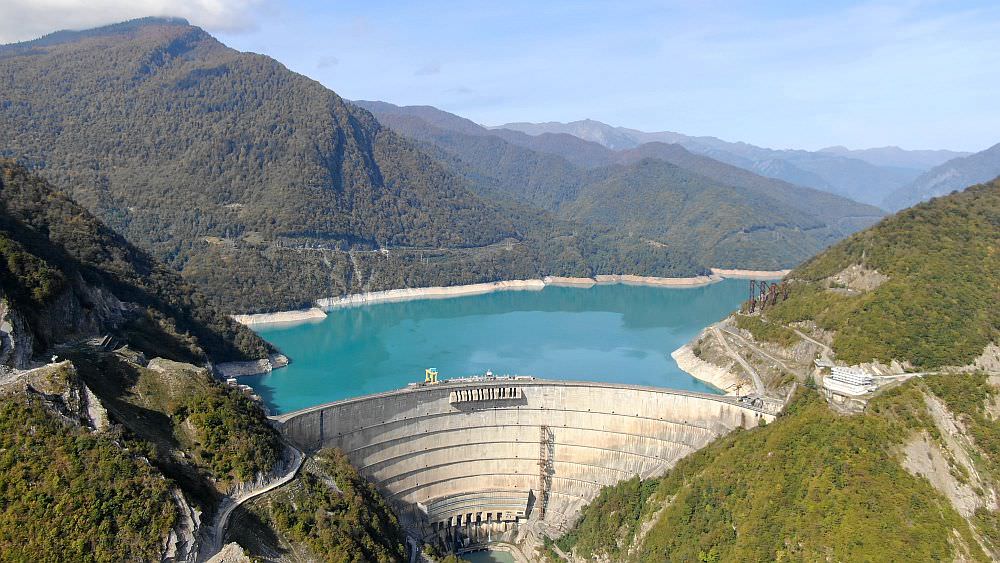
Enguri dam in Svaneti. Two other large dams are currently being planned
Disputed land ownership
For hundreds of years, the ownership of land i Svaneti was determined by so-called "traditional ownership". These lands got expropriated during the Soviet period but after the dissolution of the Soviet Union, during the period of lawlessness, Svan families redistributed them again based on traditional rights. The problem was that they did it only informally and from the legal point of view, the land still belonged to the state.After the state gained full control of Svaneti in 2004, it realized that there is a great difference between the land maps (which show all land as belonging to the state) and "traditions ownership". And introduced the procedure which let Svans register their lands also officially. However, many families which tried to register lands in the vicinity of tourist infrastructure or planned hydropower dams found out that the state did everything possible in order to block the process. As a result, projects such as Hatsvali skiing resort or Mestia airport were built on confiscated land and no compensations were given. This situation caused a lot of bad blood, caused several protests and is not cleared out till today.
Tourism
Tourism is truly a double-edged sword. It has indisputable benefits - the money it brings to the region are used to improve the local infrastructure, build roads, repair crumbling towers. Also, tourism helped to reverse the trend of depopulation of Svaneti. Young people started to return to the land of their ancestors because of the better economic opportunities. Yet, everything has a price and there are reasons why the people from other parts of Georgia speak about tourism development in Svaneti not only with jealousy but also with a bit of mockery and horror.The problem is that the mass tourism is changing Svaneti at unprecedented speed. Svans originally lived off the land but suddenly, a new, much faster way to make money has emerged. Some people adapted faster than the others, opened guesthouses and got rich. And while many tourists are attracted by "traditional way of life", the people who still live this way do not benefit from the sudden influx of tourists and are as poor as before. If nothing changes, all Svans may eventually abandon herding and agriculture, build guesthouses on their farmland and ski sloped on their pastures. This authentic, self-sufficient eco-system will become fully dependent on the tourist money and lose part of its original charm.
This also spoiled relations in many communities. The life earlier was much harder but people had to cooperate and care for each other to survive. This is no longer the case - now, they compete for tourist money.
The look of the land is not the only problem - also the attitude of people is changing. People who head to Upper Svaneti to experience authentic mountain hospitality they keep hearing about are up for a disappointment. It is natural - traditional rules of hospitality are simply not compatible with mass tourism. I am not saying that Svan hospitality doesn´t exist - it does, but it stays hidden in more secluded valleys and is hard to find at the "must-see" places.
Yet, I don´t want to suffer too much from the nostalgic optimism and complain how better were things back then. So I will end this post with a quote by my friend Vahur Lokk, who provided another perspective:
My father was a mountaineer and spent much of his summers on both sides of Main Caucasus range from late 60ies to early 80ies. Back then Svaneti was not considered a safe area, it was a very isolated community where Soviet rule barely reached. Being a guest was one thing and old customs were honored, but a group camping somewhere in the mountains was a fair game. Up to robberies. Going solo was considered highly dangerous. So let's be happy that they have learned more civilized ways to take our money and we can walk freely in this beautiful place :)
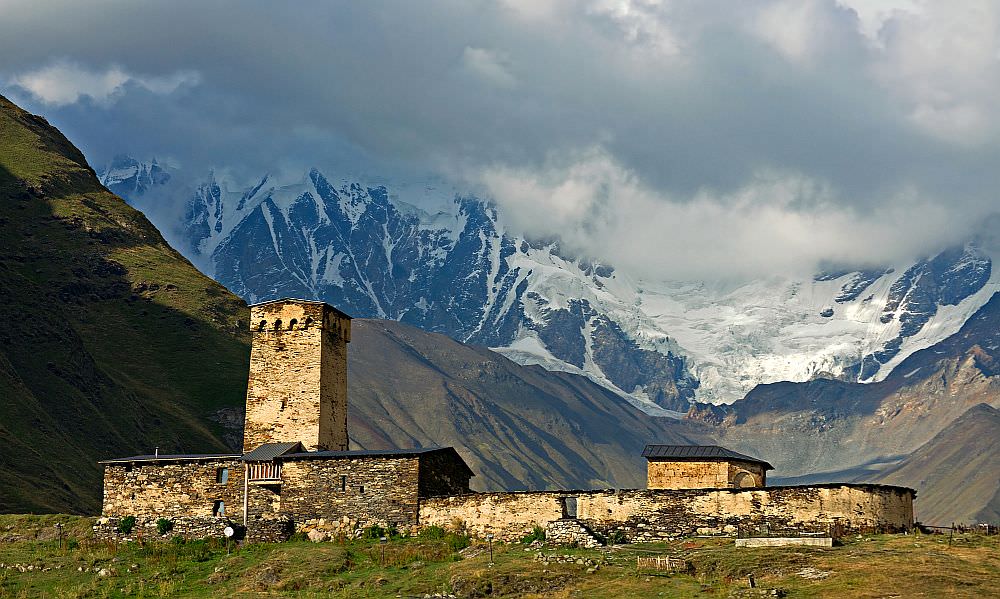
Ushguli
Ushguli
Stunning mountain village of Ushguli justly belongs to the touristic highlights of Georgia. Some people mark it as highest village in Europe. I disagree, but it really doesn´t matter -
Ushguli is not the kind of place which needs such crutches to attact tourists.
Ushguli lies in the Upper Inguri valley, only few miles downstream from the source of the river beneath the snow-covered massif of Mt. Shkhara, highest peak in Georgia.
It is actually a conglomeration of four settlements (Murkmeli, Chazhashi, Chvibiani and Zhibiani).
At the hill looking up the valley to Shkhara is 12th century Church of the Virgin Mary with defensive tower. In the village lies an ethnographic museum with great collection of golden,
silver and wooden icons dating back to 12th century. However, you dont have to go to museum to see a history here, whole village feels like one big open air musem.
You can find here over 200 historical defensive towers - also thanks to them is Ushguli since 1996 on the Unesco World Heritage List.
With its muddy streets, pigs, cows and towers Ushguli feels like a place from medieval fairytale. Unfortunately, this beauty feels quite fragile -
we can only guess how it will cope with the increased attention of tourists.
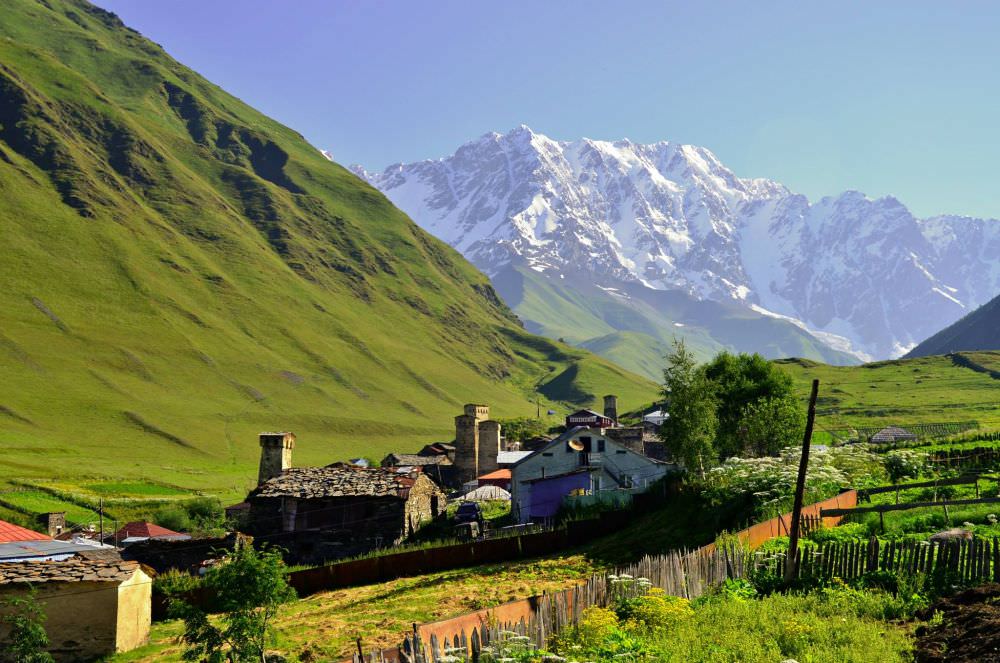
Ushguli
Svan towers
Together with mountains, the biggest attraction of Svaneti are its medieval house-towers. After all, there are many nice mountains and many nice towers in the world. But in Svaneti, there are both and match together very well. This exceptional combination of mountain scenery with medieval-type villages and tower-houses earned Upper Svaneti a place on the UNESCO Heritage list.
Svan towers (murkvam in Svan language, koshki in Georgian) were built between 10th and 18th century and reflect an organizational structure of Svan communities at this period. Since there was no higher power, each clan had to rely primarily on themselves. And needed protection not only against foreign invaders, but also against the warring neighbours (Svaneti was famous for "blood feuds" which could last even a decades). So, instead of a single circular fortification, Svan villages were dotten by dozens of fortified houses.
The usual Svan tower is built of shales, has a square footprint and is 25 - 30 meters high. The entrance, located at the second floor is accesible only by a ladder or a wooden staircase so it can be removed at the case of emergency and very hard to access. The tower usually has four to five storeys. The upper storey beneath the roof served as a battle platform - here were located loopholes through which could the defenders shoot at anyone approaching the tower.
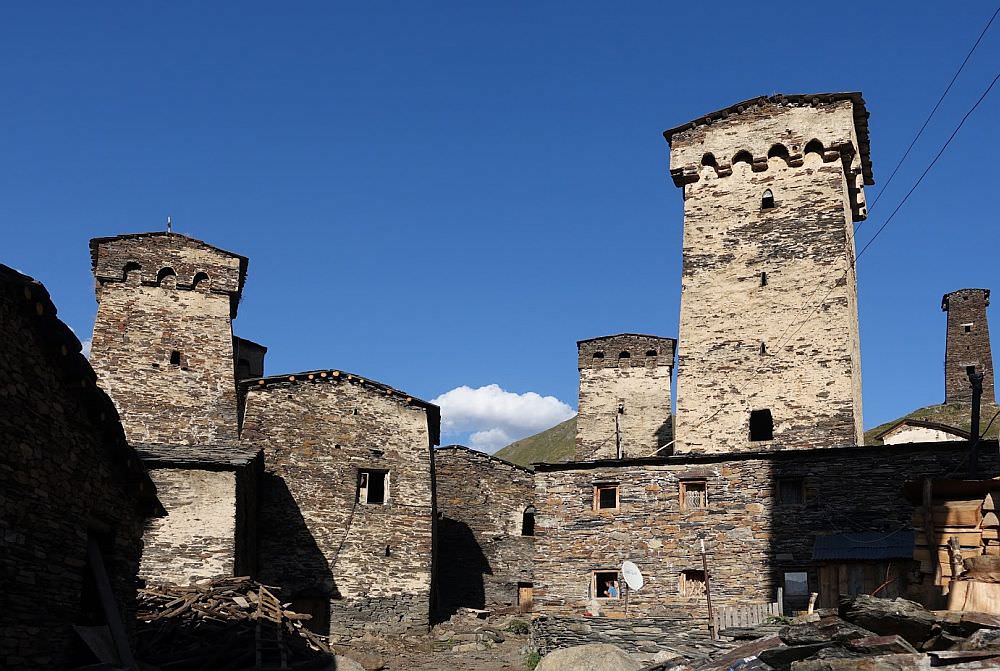
Svan towers (together with some houses)
Mestia museums
Mestia has three museums, all completely different and still pretty good. The "big one" is the Svaneti Museum of History and Etnography. It´s nice, modern and while quite small, contains really interesting selection of local artifacts - illuminated manuscripts, decorated crosses, icons, weapons, jewellery and so on. I must say I was surprised by the skill of the local goldsmiths and m<>etalworkers - I didn´t expect such delicate work in the remote mountain area. You can also climb onto the roof and enjoy the great views of Mestia. Admission fee is 5 GEL, the museum is closed on Mondays.
Then here is Margiani tower museum, which offers completely different, "down to earth" experience. It´s located in the old Svan house so you learn more about everyday life of locals, see how they cooked, slept or took care of their cattle. This musem doesn´t rely as much on the artifacts as on the explanation of the museum attendant the one we had spoke both English and Russian. During the tour, you will also climb to the top of Svan tower and visit their “prison cells”.
The last of the museums is devoted to the Mikhail Khergiani, a legendary Georgian alpinist. Mikhail climbed numerous peaks in Caucasus, Pamir, Tien-Shan and Alps (where he died at the age of 39). Museum is established in the house where he lived and displays his climbing equipment, photos, awards, paintings and so on. Interesting especially for those interested in mountaineering.
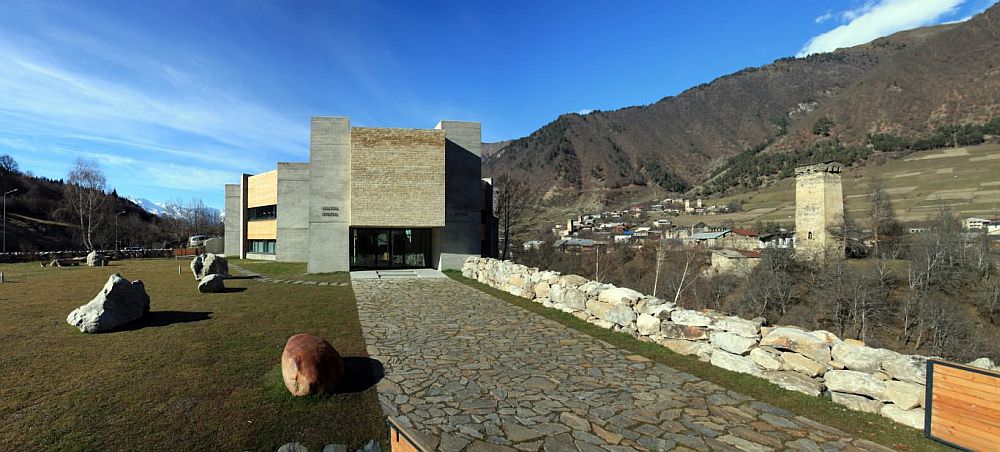
Svaneti Museum of History and Ethnography
Tower of Love
This lonely tower lies by the river, not far behind Ipari village right by the road to Ushguli. It is linked to one of many Svan legends which involves tragic love and death by jumping into the river. In this case,
Tower is open, so visitors can anytime explore its interior. However, there is not so much to explore except of the tower itself - lower floors are accesible by crude ladders,
to get higher you will have to climb on stones. Still, its pretty nice example of Svan defensive architecture.
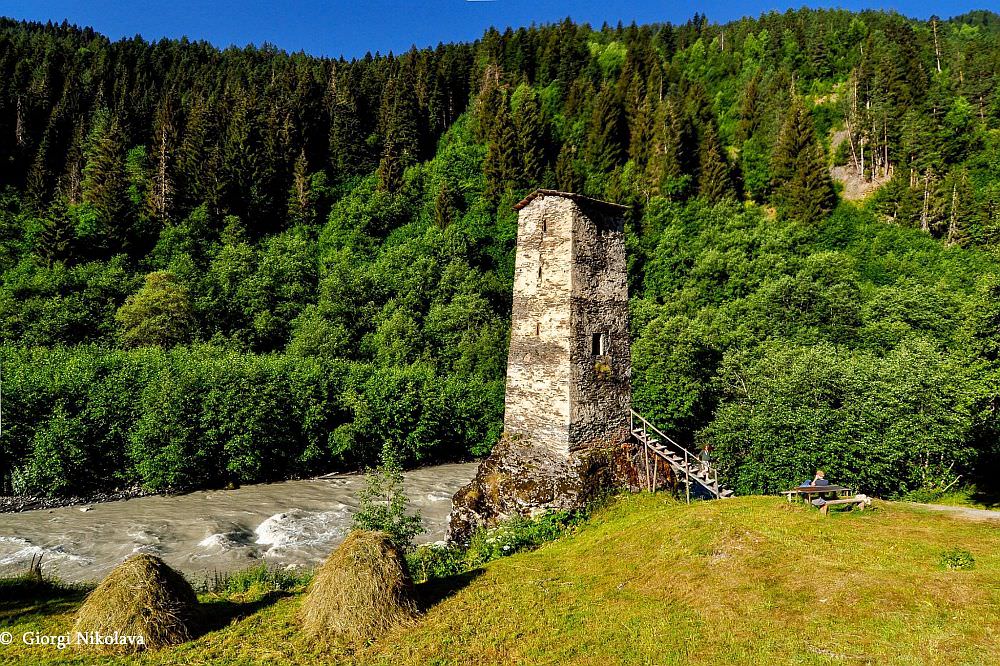
Tower of Love (by Giorgi Nikolava)
From Mestia to Ushguli
Probably the most popular multiday trek in whole Georgia and for a good reason - not too long, accesible and still provides great views and passes several traditional Svanetian villages.
- Duration: 4 Days
- Difficulty: Moderate
From Mestia to Zuruldi
Short, simple, yet very rewarding walk in the vicinity of Mestia. It offers phenomenal views of some of the most prominent peaks of Caucasus such as Ushba, Tetnuldi, and Layla.
- Duration: 3 Hours
- Difficulty: Easy
Trek to Tobavarchkhili lake
This trek crosses Egrisi mountains, which separate Svaneti from Samegrelo lowlands. The highlight of the trek is Tovabarchkhili lake - probably the most beautiful mountainlake in Georgia.
- Duration: 5 days
- Difficulty: Hard
From Mestia onto Chkhuti ridge
Great day hike which climbs onto the prominent ridge lying northeast of Mestia and offer great panoramic views. Similar to Koruldi hike but better in almost every aspect.
- Duration: 1 Day
- Difficulty: Moderate/Hard
Hike to the Mkheri church
Hike to the small church tucked at the foothills of layla mountain. Often overlooked since it doesn´t start directly in Mestia, yet one of the best day walks in the area.
- Duration: 1 Day
- Difficulty: Moderate
Trek from Mestia to Ushguli via Tsvirmi
Alternative of the most popular Georgian trek, which is by mine opinion even better than standard hike via Zhabeshi. Its main advantage are much better views on the first day, when it climbs onto Zuruldi massif.
- Duration: 4 Days
- Difficulty: Moderate
Trek to the Laila glacier
A very nice trek climbing to the foot of Mt. Laila (4008m, in georgian known as lahili), the highest mountain of Svaneti range. Mmostly used by mountaineers, but it´s pretty interesting also from a hiker´s perspective.
- Duration: 2-3 Days
- Difficulty: Hard/Moderate
Hike to Koruldi lakes (and beyond)
Nice dayhike to the group of alpine lakes lying at the foot of Mt. Ushba (and beyond, because that's where the real fun starts)
- Duration: 1 Day
- Difficulty: Moderate
From Khalde to Ushguli over Lagem pass
A great hike connecting some of the most beautiful valleys in Svaneti. It works the best as more demanding and scenic alternative for a day 4 of classic Mestia - Ushguli trek.
- Duration: 1 Day
- Difficulty: Moderate
From Mestia to Chalaadi glacier
Another popular trail in the proximity of Mestia, this one is exploring the valley of Mestiachala river. Not that hard and surprisingly nice.
- Duration: 6 Hours
- Difficulty: Moderate
From Ushguli to Chubedishi viewpoint
This hike climbs from Ushguli to the top of the mountain looming above the village. At the top, you will find several stone cairns and, even more importantly terrific views of the surrounding mountains.
- Duration: 4 Hours
- Difficulty: Moderate
Mazeri to Ushba glacier
This demanding daytrip follows the Dolra valley from Mazeri village to the foot of Ushba glacier and offers breathtaking views of Ushba mountain. On the way to the glacier you will pass beautiful Shdugra waterfall, highest one in Georgia.
- Duration: 1 Day
- Difficulty: Hard
Mazeri to Mestia through Guli pass
A beautiful, but demanding day-long hike through the Guli pass offering superb views of Ushba mountain.
- Duration: 1 Day
- Difficulty: Hard
From Etseri to Mazeri through Baki pass
A pretty nice day hike connecting two valleys of Upper Svaneti. It offers great views of Mt Ushba and its glaciers as well as a nice view of Enguri valley and Svaneti ridge.
- Duration: 6 Hours
- Difficulty: Moderate
Hike from Lenjeri to Mt. Gul
An interesting alternative to the popular Guli pass hike. It climbs 2926 meters high Gul mountain south of the pass - to reach it, you will need to cross scenic high pastures of Lashkvid.
- Duration: 8 Hours
- Difficulty: Hard
From Mestia to Tsvirmi
Amazing hike in the proximity of Mestia. It crosses Zuruldi range and offers phenomenal views on some of the most prominent peaks of Caucasus such as Ushba, Tetnuldi or Layla. Walk finishes in pictoresque Tsvirmi village.
- Duration: 6 Hours
- Difficulty: Moderate
Trek to Okrostskali lakes
Remote, difficult and spectacular - these three words best describe the trek to Okrostskali lakes. Both lakes lie in the mountains of western Svaneti, close to the border with Abkhazia. In some aspects, they resemble famous Tobavarchkhili lakes
- Duration: 3-4 Days
- Difficulty: Hard
Ushguli to Shkhara glacier
Easy dayhike in the area of Georgia´s highest mountain to the foot of Shkhara glacier and springs of Inguri river.
- Duration: 1 Day
- Difficulty: Easy
From Ushguli to Chvelpi via Latpari pass
Beautiful trek from Upper to Lower Svaneti crossing Svaneti mountain range. First half of the trek offers breathtaking views of main Caucasus ridge.
- Duration: 1 Day
- Difficulty: Hard
Hike to the Guli glacier
This demanding hike takes you from Mazeri village to the Guli glacier. The trail is little-known by hikers, but quite popular among mountaineers since it forms an approach to a classic Gabriel Khergiani route climbing South Peak of Ushba.
- Duration: 1 Day
- Difficulty: Moderate
Crossing of Lechkhumi range
This trek starts by the Shkedi village in the Lower Svaneti and crosses Lechkhumi ridge to the south by Kelida pass (3036m), close to the Chutkharo mountain. Then it descends into Sadmeli village in Lower Racha
- Duration: 2/3 Days
- Difficulty: Moderate/Hard
Crossing of Zagar pass
Nice walk on an old road connecting Ushguli in Upper Svaneti and Mele village in Lower Svaneti.
- Duration: 2 Days
- Difficulty: Moderate
From Chuberi to Nakra over Utviri pass
Nice trek traversing western, less-visited part of Svaneti. It connects villages in two remote, (still) pristine valleys and also offers great views from the area around Utviri pass.
- Duration: 10 Hours
- Difficulty: Moderate/Hard
From Nakra to Etseri
This trek explores non-touristy, little-visited parts of western svaneti. it follows roads and trails connecting ancient, almost abandoned svan villages lying in the hillside north of Enguri valley.
- Duration: 1 Day
- Difficulty: Moderate
Trekking from Svaneti to Racha
This beautiful, but very demanding trek takes you to some of the most remote parts of Caucasus. It follows the old road, which once connected Zeskho village in Svaneti with Ghebi village in Racha, but fell into disrepair long time ago.
- Duration: 3 days
- Difficulty: Very Hard
From Mestia to Tsvirmi by Enguri valley
Another route connecting Mestia with Tsvirmi village. This one crosses the Zuruldi massif to the Enguri valley and then follows it, passing several small, non-touristy settlements.
- Duration: 1 day
- Difficulty: Moderate
Canyons, caves and waterfalls of Askhi massif
Discover one of the most diverse regions of Georgia on foot. Canyons, caves, and waterfalls - foothills of Eastern Samegrelo have it all.
- Duration: 1-4 days
- Difficulty: Moderate
Trek to Memuli lakes
The Western Svaneti, and the vicinity of Nenskra valley in particular, is known for an abundance of beautiful glacier lakes. This trek explores some of them, situated in the remote reaches close to the Russian border.
- Duration: 2-5 days
- Difficulty: Very hard
Trek from Lebarde to Lentekhi
Virtually unknown, yet pretty spectacular 2-day trek in the Lower Svaneti, connecting balneological resort Lebarde with Lentehi.
- Duration: 2
- Difficulty: Hard
Crossing of Nakerala-Satsalike ridge
Traverse of mountain ridges separating Lechkhumi regions from Imereti. A crazy art hut, a swinging stone, and swimming in a rather hidden mountain lake are a nice add-on which round up this slightly unusual hike.
- Duration: 2-3 days
- Difficulty: Moderate
Walk from Mazeri to Latali
This trail offers the most direct connection between villages Mazeri and Latali as well as some nice views of Ushba, Enguri valley and Svaneti range.
- Duration: 3 hours
- Difficulty: Easy
Hike to the Khvamli mountain
Thanks to its striking shape and isolated position, this mountain situated north of Kutaisi is home for many legends such as the Prometheus tale. Khvamli can be walked as a short hike or as the starting point for longer adventures.
- Duration: 2-3 hours
- Difficulty: Easy
